Prized and Played showcases over eighty beautiful, antique chess sets from across the centuries and around the world, as well as many interesting artifacts related to the history of chess.
Prized
Intended to be shown as objets d’art rather than used in play, ornamental chess sets are testaments to the artistic skill of their creators, as well as the refinement of the wealthy patrons who commissioned them. Freed from the confines of practicality, artists created chess sets of great beauty and originality. Master carvers flaunted their expertise in manipulating luxury materials such as ivory, gold, silver, pearls and precious stones in these ornamental chess sets. Many feature elaborate gilded decoration, delicate carving, and tall forms that made them less than ideal for playing, but perfect as demonstrations of wealth, or as a generous gift for a friend.
Ornamental sets were also symbols of the erudition and sophistication of their owners. Several of the ornamental sets in this show have themes drawn from history, mythology, or religion. The Good Versus Evil set contains bishops holding copies of Dante Alighieri’s The Inferno, while another set pits Venus and Bacchus, two figures from Roman mythology, against each other. Other artists turned to contemporary military conflicts for inspiration. The army of the British East India Company combats Indian military forces in John Company sets, while other sets celebrated the exploits of Emperor Napoleon. Ornamental sets could also show that a person was well-traveled. A set from Dieppe, France, where master carvers produced lovely ivory products could indicate the owners had traveled to the popular resort town. Swiss Charlemagne sets, produced in Brieze, Switzerland, were also marketed to tourists in catalogues.
These sets were so prized by their owners that, despite their delicate nature and rich materials, they have survived centuries later as examples of the excellent craftsmanship of their makers. They continue to be valued, not only for their aesthetic qualities, but also for the fascinating stories they tell.
Played
In Prized and Played, superb examples of antique playing sets from across Europe and Asia illuminate the fascinating history of stylistic evolution of chess pieces. Though some of the sets in this half of the exhibition feature elaborate decoration, they were all intended for use in play. Their widely varied appearances testify to the imagination and stylistic preferences of the artisans who created them, as well as the artistic tastes of the players who used them over the centuries. They were made of durable materials like wood, ivory, bone, and metal so that players could regularly use them for play over many years. While the style of the simple, brightly colored, and dome-topped Islamic sets in the show stands in contrast to that of the European sets, diverse styles of playing sets were often manufactured within the same country. Some examples include the Directoire, Régence, and Lyon style sets produced in France, or the Barleycorn and Northern Upright style sets manufactured in England.
The nineteenth century brought the rise of modern organized chess tournaments and clubs, which highlighted the need for standardized chess pieces. The regional styles that had proliferated in previous centuries led to confusion and contention when the great players of numerous nations gathered to compete. Prominent chess manufacturers of the early-to-mid 19th century England began to stabilize the designs of playing sets into recognizable precursors of the sets we use today. John Calvert set up shop in 1791 at 189 Fleet Street, London, and mass-produced several designs that grew in popularity. These designs, as well as fancier playing sets imported and sold by James Leuchars and other retailers in the initial years of the 19th century, influenced subsequent well-known London chess manufacturers such as George Merrifield, Thomas Lund and his son William, and Charles Hastilow.
Finally the iconic Staunton chess set, designed by architect Nathaniel Cooke and endorsed by the famous English player Howard Staunton, emerged during this period. The sets were first manufactured and sold in 1849 by John Jaques and Son, Ltd, of London, and later became the standard for tournament play.
Philosophy of Collecting
The guiding principles of a chess collector can evolve over time as the collection grows and takes shape. My initial acquisitions were driven by a lifelong love of the game itself. It was a thrill to purchase an antique playing set and touch the well-worn pieces from chess games of the distant past. One acquisition led to another, and eventually I had to admit—to myself and others—that these chess sets, which were now overflowing from one room to the next, formed a collection, which also meant that I had somehow become a collector.
Nowadays things are different. My collection has expanded to include ornamental sets, which were created as objects of beauty rather than intended for use in actual play. I also collect antique chess boards, timers, publications, and chess miscellanea. Every collection must have boundaries, and mine is defined by two words: “chess” and “antique”. But even these concepts are not quite specific enough. Does “chess” include variants or similar games? For my collection, generally not, so I don’t collect xiang xi (better known as Chinese Chess). However, I do have several antique Thai/Cambodian makrook sets. These sets and boards can be used for normal chess, even though the rules of makrook are somewhat different.
“Antique” also has a boundary definition. Generally I collect items created prior to the 20th century. Victorian-era (roughly 19th century) sets have special importance to me, due to the extensive archival research I’ve done on the manufacturers and retailers of those sets. Earlier chess sets can be even more desirable because of their age, rarity, and oftentimes superlative craftsmanship.
Two other guidelines I have set for my collecting are “quality over quantity” and “seek the unique.” I am constantly searching for high-quality sets with rare and beautiful features. This was not always the case; early on, my collection lacked some of the “must-have” types of antique sets: a Russian Kholmogory set, a Rajasthan canopy set, a Pulpit set, and so on. But as my collection has gradually matured, those gaps have been filled. So now I focus on rare, or even one-of-a-kind, antique sets.
What about restoration for a damaged antique set? There are two schools of thought, equally valid, in my opinion. The first school says that damage is simply part of the history of a set, and should be left as-is. I have friends in the collecting world who follow that doctrine, and I respect them for it. But my own opinion is in line with the other viewpoint, that careful restoration can honor the intentions of the creators of the sets. One important corollary is that any restoration should be fully and accurately documented, so that the set’s historical provenance is complete.
This last point is very important, and is worth stating in an even larger context: collectors have a solemn responsibility to the collecting community—and even to history itself —to accurately represent all aspects of the artifacts of antiquity. There is no place in the arts, sciences, or any other human discipline for historical items that not fully authentic, or even worse, misrepresented. It is a “higher calling” of the collector, as it would be for a historian or museum curator, to ensure that the relics of past eras are passed on to future generations with confidence and valid provenance.
With regards to the future, I don’t know where my collecting interests will take me next. Like the game of chess itself, my chess collecting experience has always been filled with new excitement and new discoveries. Wherever it chooses to take me, I’ll certainly go along for the ride.
—Jon Crumiller
About the Collector
Jonathan Crumiller
Jon Crumiller’s background as a tournament chess player and avid follower of the game inspired his passion for collecting antique playing sets. Over time, he has increased the scope of his chess collection, which now includes over 600 ornamental and playing sets, as well as chessboards, timers, books, and chess miscellanea, mainly from the 18th and 19th centuries. Ever inquisitive about the origins of these antique sets, Jon often conducts research projects about the evolution of chess set styles, usage, and manufacturing. He enthusiastically shares the results of this research with the wide community of collectors. Jon also maintains a website with photos of his exquisite collection at www.chessantique.com.
Jon’s tournament experience stretches back to Fischer-boom years in the early 1970s, and includes a State Championship title (Delaware) and numerous other tournament victories. Along the way, he has earned the USCF National Master title in both over-the-board and correspondence chess. Still active via online chess, Jon credits much of his middle-age chess improvement to the outstanding teaching skills of his friend and chess teacher, Grandmaster Lev Alburt.
Jon and his wife Jenny live in Princeton, New Jersey, and have three adult children and one grandchild. Jon is Co-founder and Chief Operating Officer of Princeton Consultants Inc., a mid-size consulting firm that specializes in business optimization and operational efficiency. Jenny is an elected official on Princeton Council, the governing body of Princeton, NJ.
Artifacts Featured in the Exhibition: Prized
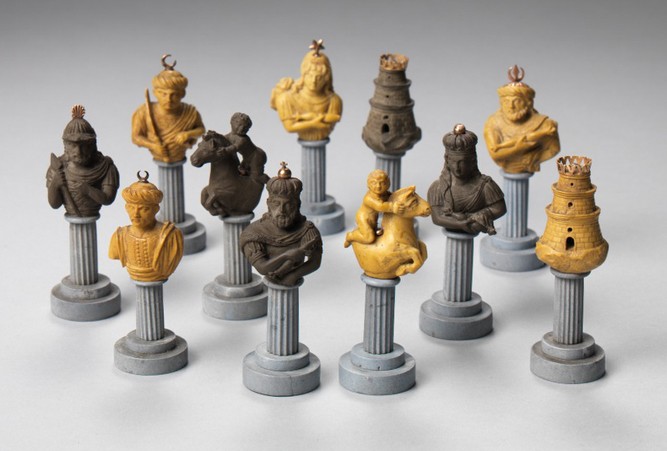
Italian Marble and Basalt Bust Chess Set, c. 1875-1900
Italy
Marble, Basalt and granite with bronze mounts
King: 3 1/4 in.
Photo © Bruce M. White, 2013
Beautifully carved busts of basalt and yellow marble sit atop fluted columns in this chess set, which was probably created during the late nineteenth century. The gold side likely represents the Sasanian Persian Empire, while the dark side, carved from an igneous rock called basalt, possibly represents the Byzantine or Greek Christian (Eastern Roman) Empire. The busts are attached to the pedestals by embedded bronze pins, the tops of which are the gilt bronze mounts on each of the chessmen. The Persian side features mounts with crescents and stars, symbols of Zoroastrianism in Persia/Iran, while the opposing side’s king has a cross atop an orb, a symbol of Christianity, on his mount.
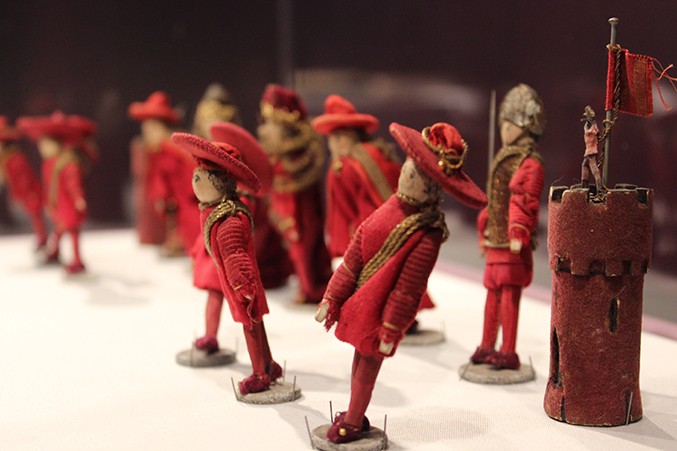
Neapolitan Cloth Doll Set, c. 1900
Probably Naples, Italy
Silk, lead bases
King: 3 1/2 in.
Photo © Bailey Dolenc
These cloth and silk dolls are a unique departure from the ivory, wood, and metal chess pieces more commonly found in decorative sets. Created around the turn of the twentieth century, the dolls have wooden peg bodies and stand atop lead bases. The use of real fabric for clothing gives the figures a dimension not often feasible in carved sets, with the monarchs donning jeweled crowns, the knights in helmets and chain mail, and pawns wearing wide-brimmed hats, used to protect peasant farmers from the heat of the sun during long hours of outdoor work.
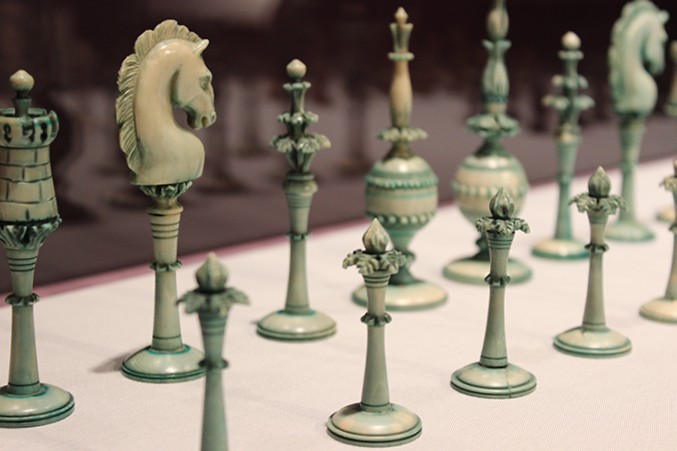
Turkish-Style Carved Ivory Set, c. 1900
Possibly Turkey
Ivory
King: 5 1/4 in.
Photo © Bailey Dolenc
The kings, queens, and bishops in this Turkish-style chess set are depicted through botanical forms atop elongated pedestals, rather than figural portrayals. Beaded decoration adorns the round bases of the kings and queens. The knights are horses’ heads with raised manes, while the rooks are pierced turrets, or small towers. The kings, queens, bishops, and pawns in this set resemble their corresponding pieces in tulip-style chess sets.
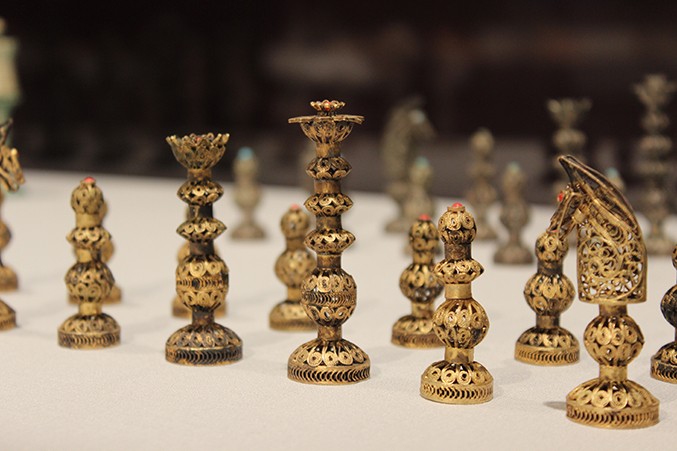
Israeli Silver Filigree Set, c. 1960
Israel
Gold and silver with semi-precious stones
King: 3 1/4 in.
Photo © Bailey Dolenc
Filigree is a metalworking technique that can be traced back to the ancient Greeks and Etruscans. Commonly found in jewelry, it involves fine metal threads being woven, curled, or twisted together to form delicate, intricate patterns. This modern set, made in Israel in the mid-twentieth century, is made of gold and sterling silver and mounted with semi-precious stones.
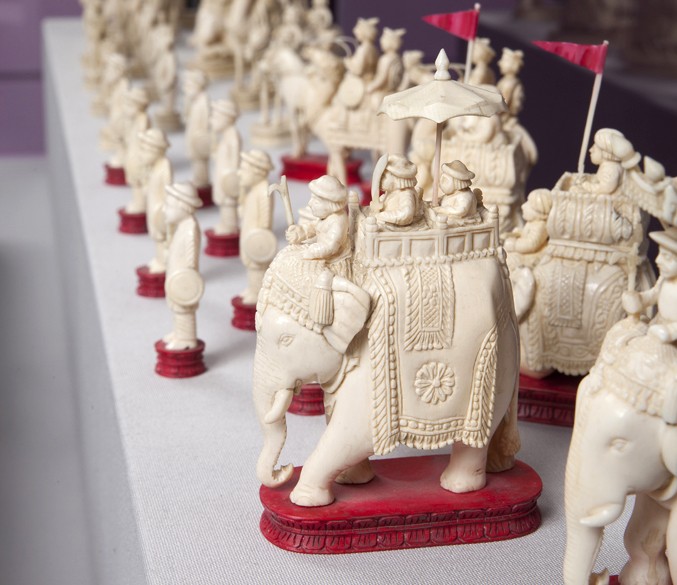
East India “John” Company Set with Sitting Elephants as Rooks, Mid-19th Century
India
Ivory
King: 5 1/2 in.
Photo © Michael DeFilippo
The seated elephants representing rooks add uniqueness to this John Company set, which shows warring British and Indian military forces. The carver of this set took care to give the animals in the set different personalities. The elephant on the king pieces stands with its trunk relaxed, while the elephant on the queen appears more agitated, and twists its trunk. The camels throw back their heads, while the horses show their teeth. The delicately carved ivory reins, umbrellas, and flags are all indications of the set’s purpose as a work of art to be admired, rather than a set to be played.
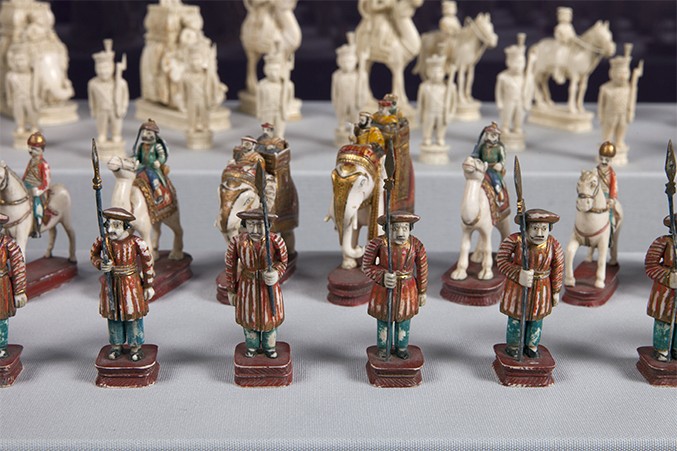
Bengali Ivory Polychrome Set, Early-mid-19th Century
India or possibly the region of Bengal
Ivory
King: 3 1/4 in.
Photo © Michael DeFilippo
Located in the eastern region of the Indian subcontinent, the region known as Bengal today comprises two distinct but neighboring geographic areas: the country of Bangladesh and the state of West Bengal in India. The intricate carving and original polychrome painting found on the pieces distinguishes this set, which features two opposing royal families in red and green, the colors traditionally used in early forms of chess.
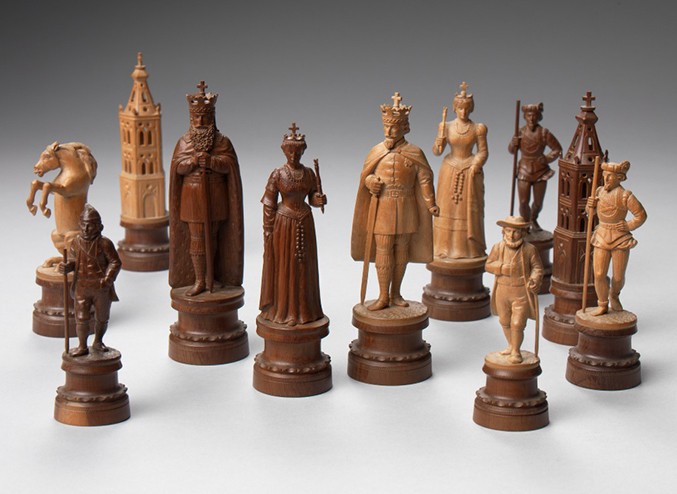
Swiss Charlemagne Wooden Figural Set, c. 1875
Switzerland
Wood
King: 4 3/4 in.
Photo © Bruce M. White, 2013
Once thought to have been produced in the Black Forest region of Germany, sets like these used to be called Luther sets. Recent research has shown that these sets were carved in Brieze, Switzerland, and were advertised to tourists of the late nineteenth century in catalogues. Sets of this type are known for their fine carving, and this one features individualized pawns in varying poses and dress. The title Swiss Charlemagne is a designation created by the chess collecting community.
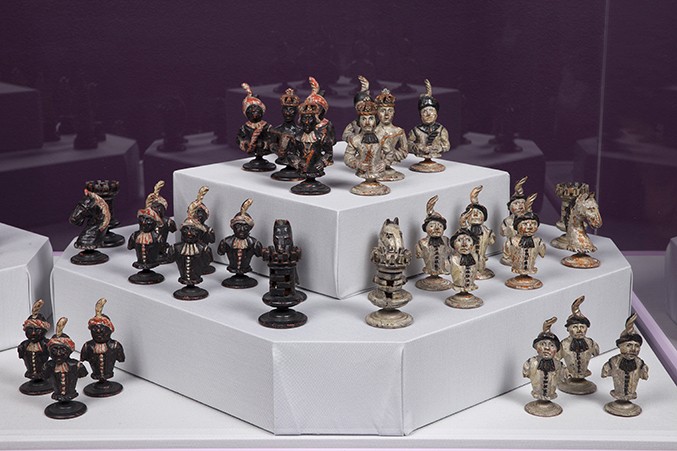
Northern European Painted Wooden Set, Second half of the 18th Century
Northern Europe
Painted Fruitwood
King: 3 1/2 in.
Photo © Michael DeFilippo
The blushing cheeks and red noses of the warring European and African figures create a sense of lighthearted humor in this carved fruitwood set. The kings in the set hold staffs, while their queens clutch fans close to their chests. The pawns, who wear ruffed shirts like the kings, have hats topped with feathers. This set once belonged to Jean Manoury, a famous chess collector who lived in Paris, France, in the early 1900s.
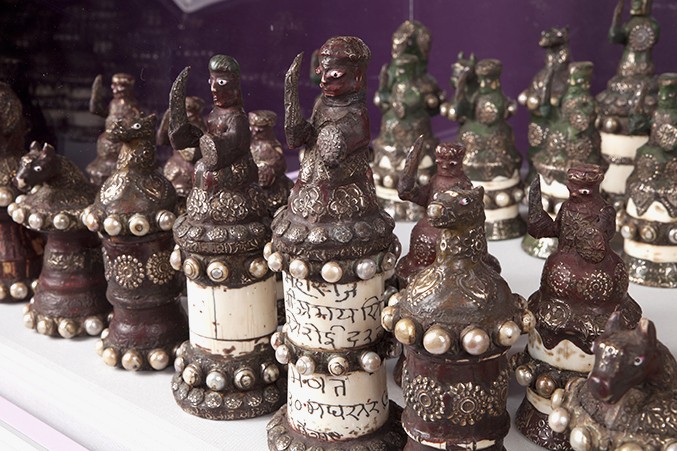
Royal Rajasthan Set, 1873
India
Silver and bone with pearls, cloth board
King: 7 1/4 in.; Board: 43.31 x 43.31 in.
Photo © Michael DeFilippo
Made in 1873, this chess set bears Devanagari and Arabic inscriptions that give extensive information about the circumstances leading to its creation. Commissioned in 1873 by the Maharaja Abhay Singh, the set was made by the artist Daud as part of the dowry for the Maharajah’s daughter. It commemorates an event of the eighteenth century, when the Muslim ruler of Tonk, a district of Rajasthan, India, attempted to capture the treasures of the Hindu king of another region called Sirohi. With the help of other Hindu leaders, the king of Sirohi was able to recover his property. In this set, the Hindu military is represented by the brownish red pieces, while the Muslim forces are colored green. The expensive materials that compose the pieces—silver and pearl—testify to the wealth and power of Maharajah Abhay Singh, who purchased the set.
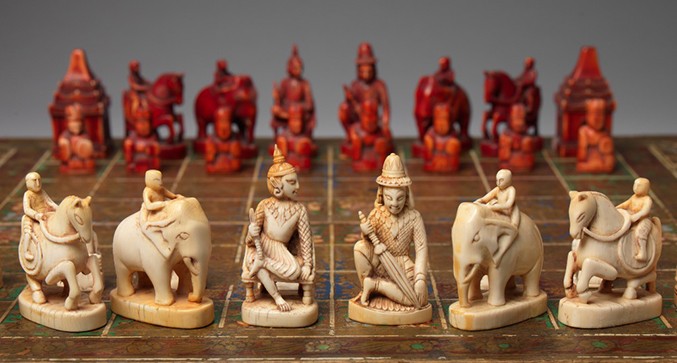
Burmese 18th Century Set and Kashmir Chessboard, 18th Century
Pieces: Burma, Ivory King: 2 3/4 in.
Board: North India, Wood Board: 23 x 1 1/2 in.
Photo © Bruce M. White, 2013
This rare, Burmese-style chess set represents two armies, led by the seated kings and their great generals. They are followed by military figures atop elephants and horses, while tiered temples represent the rooks. The seated pawns are compactly posed figures bearing weapons and shields. This set is displayed on an eighteenth-century Indian board that serves two purposes. It can be used for playing chess or nard, a game with similar rules to backgammon. The perimeter of this beautiful board has bright floral polychrome decoration.
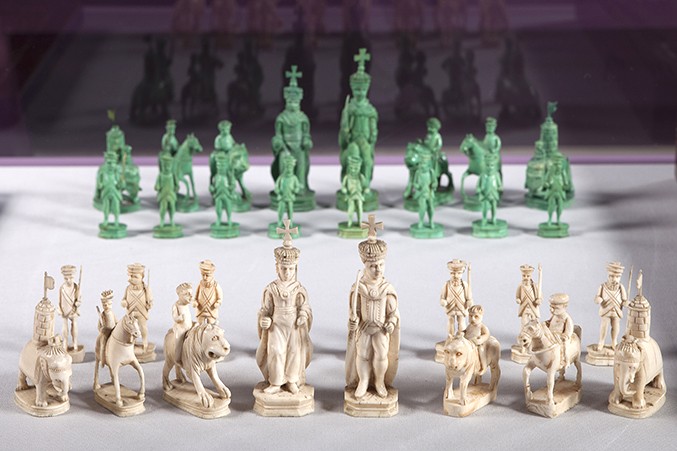
Central Provinces Green and White Set, Early 19th Century
India
Ivory
King: 4 3/4 in.
Photo © Michael DeFilippo
Rather than including pieces featuring men on camelback, as in many other Indian chess sets, this one shows figures on the backs of snarling lions. Once thought to have been made in the Central Provinces of India, the set is now considered to have been produced in Vizagapatam, a district in the Madras Presidency of British India. The design of the rooks, elephants carrying towers with waving flags, as well as other stylistic features, supports this attribution.
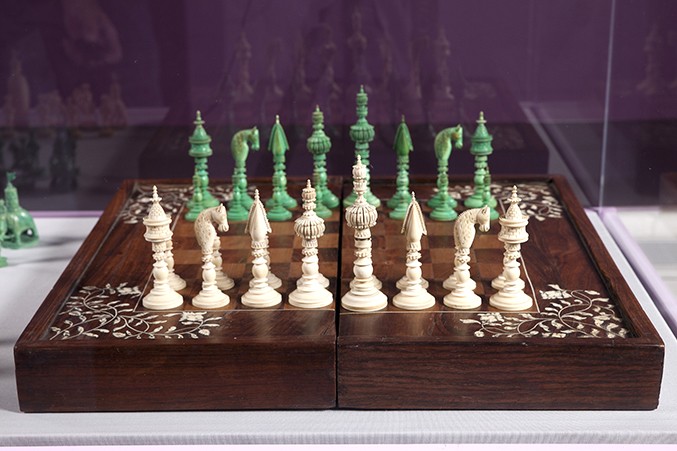
Samuel Pepys Set, late 18th or early 19th Century
India
Ivory
King: 5 in.; Board: 19 x 19 x 2 1/2 in.
Photo © Michael DeFilippo
This Samuel Pepys set is named not for its maker, but for a famous man said to have owned another set of the same type. Made in India, it features a hybrid of British and Indian stylistic influences. The towers on the rooks, as well as the shapes of the bishops, communicate the taste of the British consumers of the sets, while the carved decorations reflect the artistic traditions of India. The tall, slender forms of the sets made them impractical for playing, as they could be easily knocked over during a game. However, they were valued as gifts, and it has been said (though not proven) that King James II of England gave one of the same style to Samuel Pepys, a naval administrator and member of Parliament famous for his diaries.
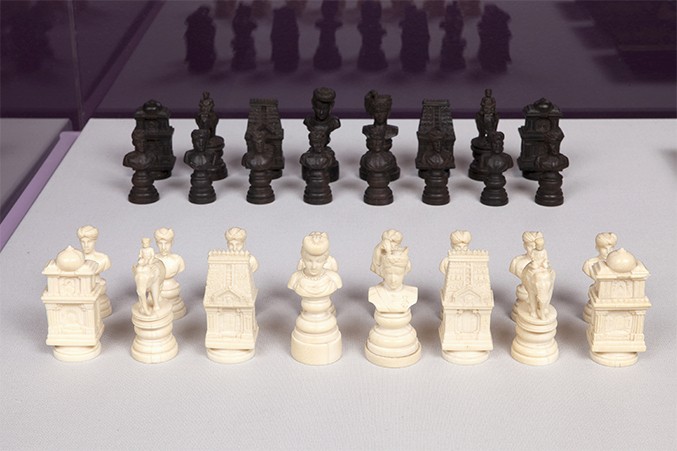
Cambodian Ivory and Wood Set, c. 1850-1900
Cambodia
Ivory and Wood
King: 2 3/4 in.
Photo © Michael DeFilippo
This set represents a blend of the styles of the chess sets that were produced in Europe and Southeast Asia in the nineteenth century. Cambodia became a protectorate of France in 1863 and was governed as part of the colony of French Indochina. This blending of cultures is evident in the pieces of this set, which has highly individualized figural busts as kings, queens, and pawns, as in French sets of the same century. The king wears a military uniform with a sash, while the queen has an elaborate hairstyle—these figures may represent specific historic individuals. The set also has figures riding elephants as knights, and bishops and rooks represented by detailed pieces resembling the gorgeous monumental architecture in the country, features common in sets from Southeast Asia.
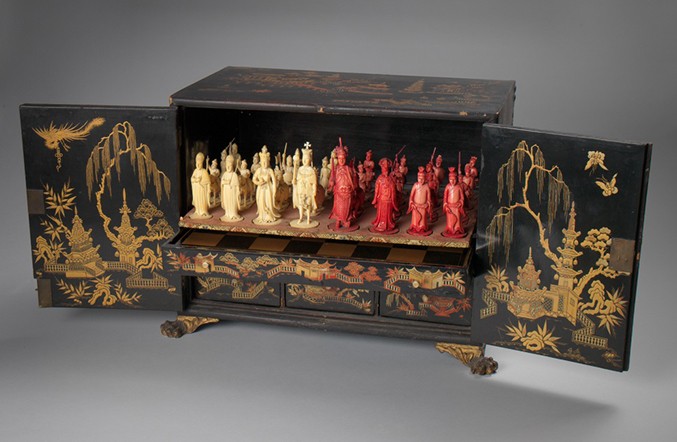
Cantonese King George Set, Early to mid 19th Century
Canton Province, China
Ivory, lacquered wood cabinet
King: 4 3/4 in. Cabinet Size: 17 1/2 x 10 1/4 x 15 in.
Photo © Bruce M. White, 2013
The finest chess sets in China were manufactured in Canton, where this elegant set was created. The British introduced their style of chess to China in the late 18th century, when they established trade networks in the country. Chinese ivory artists soon began producing gorgeous chess sets both for export and visiting tourists. Made for the British market, this set shows British forces battling the Chinese. The artist took great care to create an army of pawns in diverse poses holding weapons of various types. Though the British monarchs represent specific historical figures, namely King George III and Queen Charlotte, the Chinese side has figures influenced by mythology. The king wears an elaborate robe decorated with a fearsome beast, and may be influenced by representations of Torgchou, the god of war, in traditional plays about Chinese mythology.
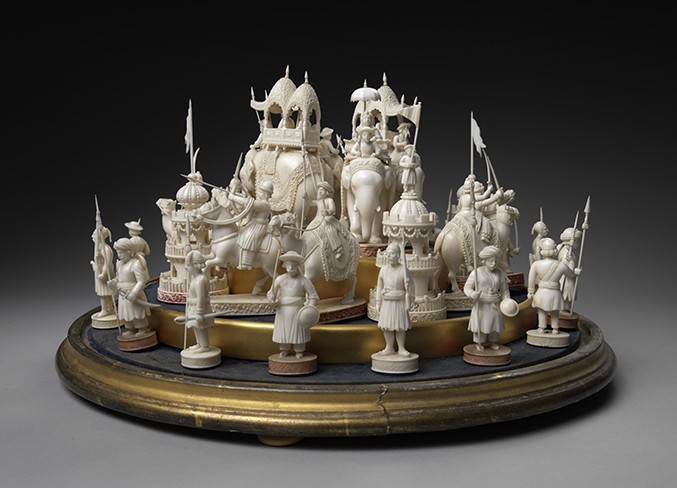
East India “John” Company set, Early to mid-19th Century
Berhampore, India
Ivory
King: 5 1/2 in. Dome: 16 3/4 in. diameter; 13 in. high
Photo © Bruce M. White, 2013
East India “John” Company chess sets earn their name from the nickname of the East India Company, which operated in India until 1874. Some of the “John” sets depicted the army of the East India Company combatting an Indian army. A carving center staffed by master artisans was established in Berhampur, India, where the British had built a military barracks. There, beautiful chess sets like this one were produced to meet the demand of British citizens living in India, as well as visiting tourists and foreign dignitaries. This set is displayed on its original display stand and glass dome.
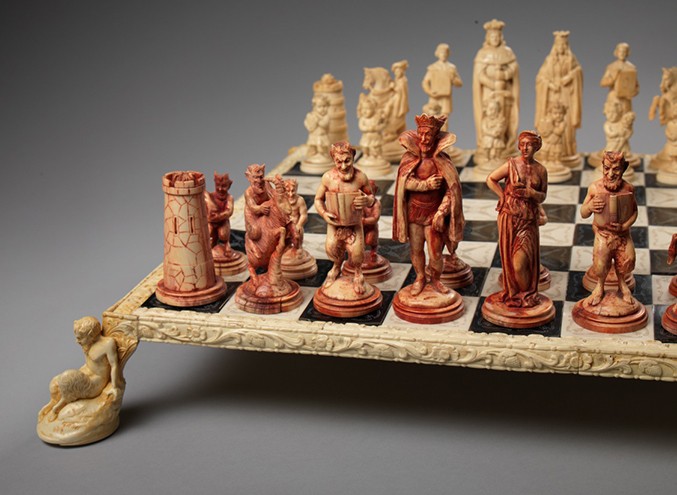
Italian Good-versus-Evil Ivory Set and Chessboard Replica, 18th Century
Italy
Pieces: Ivory, King: 5 1/4 in.
Replica Board: Wood, horn, faux ivory Board: 21 1/4 x 21 1/4 in.
Photo © Bruce M. White, 2013
Satyrs led by Mephistopheles in red face off against a pious group of figures, led by a saintly king and queen in this set, which embodies the theme of good versus evil. The good pawns are putti holding symbols of the virtues of love and charity, while the evil pawns are imps that represent sins like greed. The evil bishops hold open copies of Dante Alighieri’s epic allegorical poem The Inferno, which tells of the Roman poet Virgil’s journey through the different circles of hell. They are opposed to the staid good bishops, who carry the Bible. The evil knights ride goats, animals associated with sin, rather than horses, like the knights on the side of good. The evil queen poses seductively, an embodiment of lust in stark contrast with her virtuous counterpart. This set sits atop a replica of the original board.
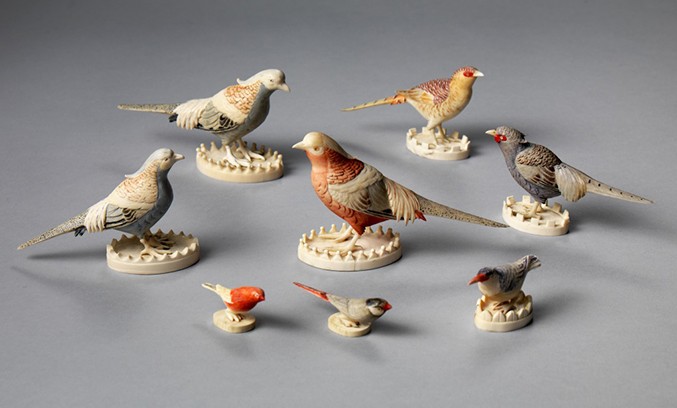
Bird Set, c. 1900
Probably China
Ivory
King: 3 1/4 in
Photo © Bruce M. White, 2013
This charming carved ivory chess set shows a flock of colorful birds, which includes ducks, pheasants, and kingfishers. Each piece features finely carved plumage; on one side the feathers are painted in shades of red, yellow, and pink, while the other features cool shades of blue and gray. The bases of the pieces resemble the symbols of European-style chess pieces—crowns for kings and queens, miters for bishops, horseshoes for knights, and castellation for rooks. This set is unique and possibly made in China as a special commission.
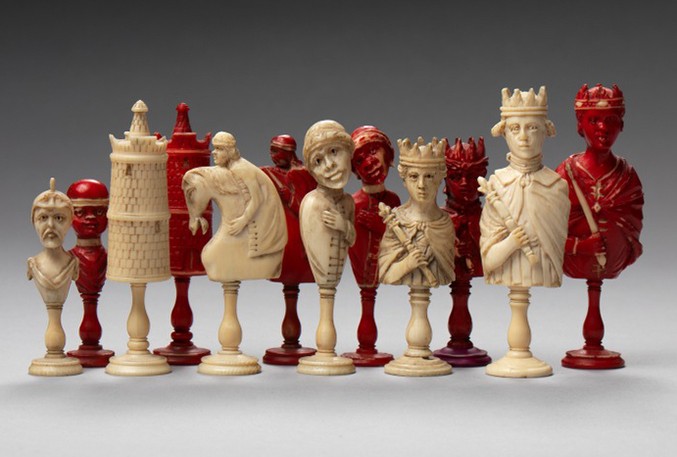
Dieppe Europeans vs. Africans Ivory Set, c. 1800
Dieppe, France
Ivory
King: 3 1/4 in.
Photo © Bruce M. White, 2013
In the seventeenth century, Dieppe, a French city located on the English Channel, became a center of ivory working. Artisans there created chess sets from African ivory imported from the country of Senegal. Often, these sets had humorous aspects, caricaturing contemporary figures. After the French Revolution, there was less of the wealthy patronage and foreign tourism that had supported the ivory trade in Dieppe, and production of fine ivory products in the area decreased. The theme of Africans versus Europeans was very popular during the nineteenth century, when many European nations were expanding their territory on other continents. This set pits a European monarch, in white, against an African sovereign in red. The hobby horse knights are characteristic of late eighteenth-century Dieppe sets, and even appear in a similar set that was owned by Thomas Jefferson.
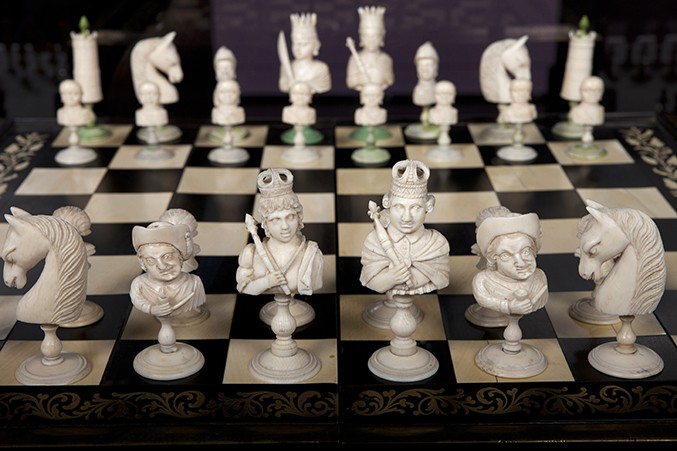
Dieppe Green and White Ivory Figural Set, Mid-19th Century
French
Ivory and Ebony Board-Box, c 1850-1900
Pieces: Dieppe, France; Ivory; King: 3 1/2 in.
Board: France; Ivory, ebony; Board Size: 21 1/2 x 18 1/4 in.
Photo © Michael DeFilippo
Chess sets created by the master carvers of Dieppe, France, were sought-after souvenirs among British tourists who visited the coastal town. This set features the theme of European military forces attacking those of Africa, a popular subject among the tourists and artists in Dieppe. This set substitutes grimacing fous, or fools, for the bishops. Though the production of ivory products in Dieppe decreased after the French Revolution, it was revived after Napoleon bought ivory products there. This set is presented on an ebony and ivory board embellished with a border of golden acanthus leaves.
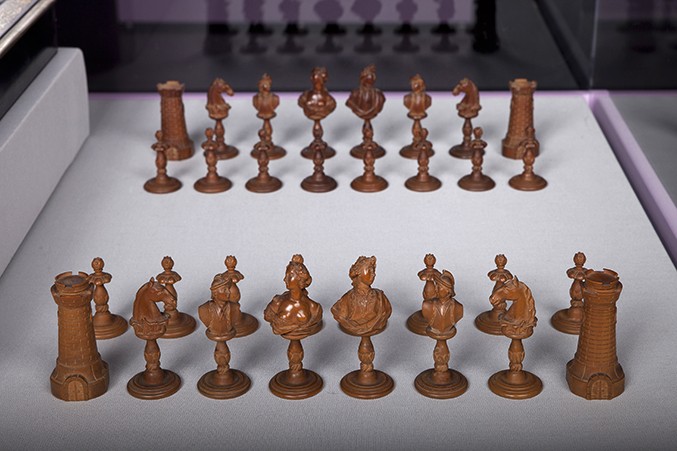
French 18th Century Wooden Set, 1765-1775
France
Boxwood
King: 3 1/2 in
Photo © Michael DeFilippo
The contrasting poses of the bust-length figures add a sense of motion to this French boxwood chess set. The kings, queens, bishops and knights are supported by baluster stems decorated with petals on their bases. The rooks are represented by lighthouses, while the pawns are budded flowers atop balusters. The kings wear laurel wreaths, symbols of victory and power.
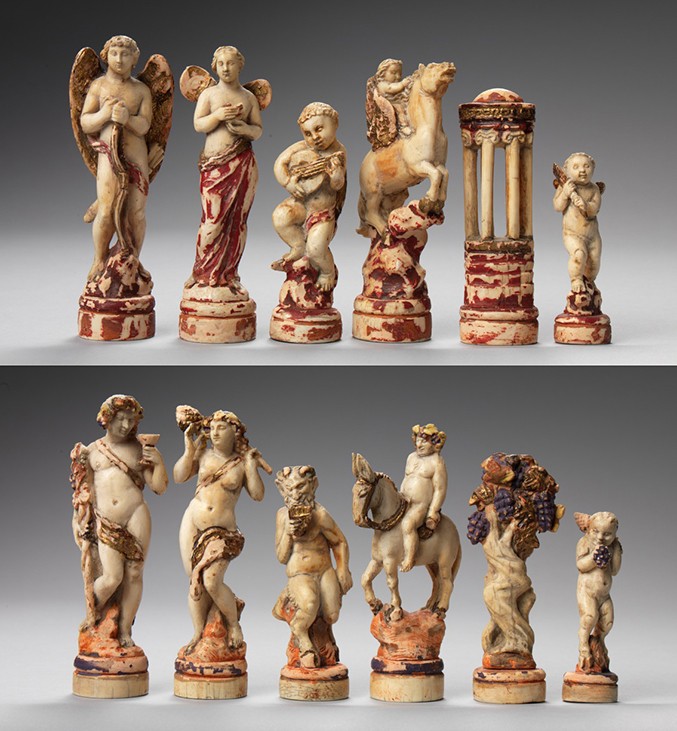
French Polychrome and Gilt-Heightened Carved Ivory Figural Set, c. 1875-1900
France
Polychromed and gilded ivory
King: 5 1/4 in.
Photo © Bruce M. White, 2013
The Roman goddess Venus and her son Cupid lead their retinue against Bacchus and Bacchante, his female follower, in this set which pits symbols of love against those of lust and excess. The side of excess features sensually posed figures with bare skin, while the side of love features pieces that are in more reserved positions. Bacchus’s pawns are satyrs playing pan pipes and holding grapes and the rooks are twisting grape vines, allusions to his position as the god of wine and revelry. His follower, the drunken prophet Silenus, rides a donkey as the knight. In contrast, Venus’s rooks are stately temples with Ionic columns, and her pawns are putti (winged children) playing musical instruments.
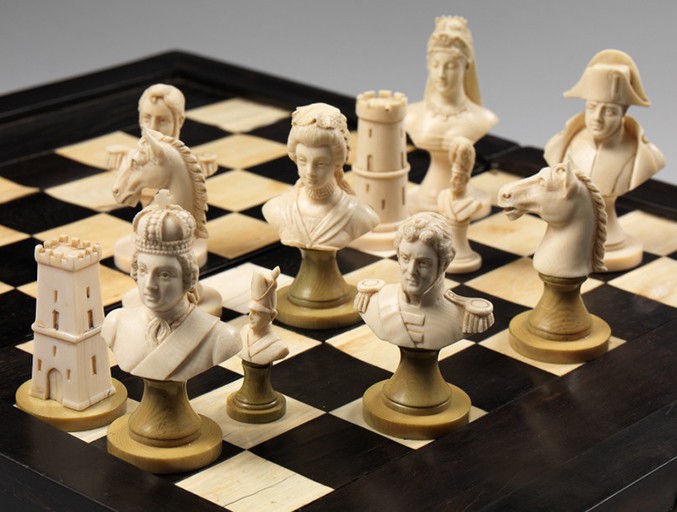
French Ivory Bust Set, 19th Century
France
Ivory
King: 8.5 cm; 3 1/4 in.
Photo © Bruce M. White, 2013
The Napoleonic Wars set the theme for this finely carved ivory chess set. Busts atop pedestals of light and green stained ivory represent leaders and military figures from the French and Allied sides. The French are represented by the light-colored pieces, with the Emperor Napoleon as king, Empress Josephine as queen, the Marshals Michel Ney and Joachim Murat as bishop, and members of the Imperial Guard wearing bearskin caps as pawns. They oppose the Allied forces under Austrian and German emperor, Frances II, with his wife Empress Maria Theresa and British Admiral Horatio Nelson and British General Arthur Wellesley. The pieces are handsomely carved and serve as portraits of each of the depicted leaders.
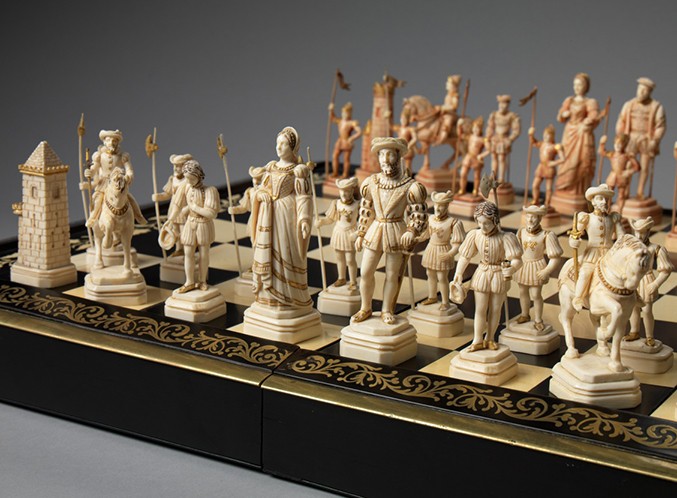
French Ivory Figural Chess Set, Late 19th Century
France
Ivory
King: 4 in. Photo ©
Bruce M. White, 2013
The gilded highlighting on this late nineteenth century chess set alludes to its theme, the meeting of the English King Henry VIII and the French King Francis I at the Field of the Cloth of Gold. The two kings, along with their retinues, met near Calais, France, in 1520 for a gathering intended to increase the bonds of friendship between the two nations. The French and the English tried to outdo each other with extravagant shows of wealth. Many of the tents and much of the clothing worn by the guests was made of cloth of gold, an expensive fabric composed of gold and silk, which lent its name to the diplomatic meeting. The English side is represented by the ivory figures with a red wash. The English pawns bear staffs with the standard of the king, whereas the French pawns hold halberds. The two sides are also differentiated through the clothing of the figures and architectural styles of the rooks.
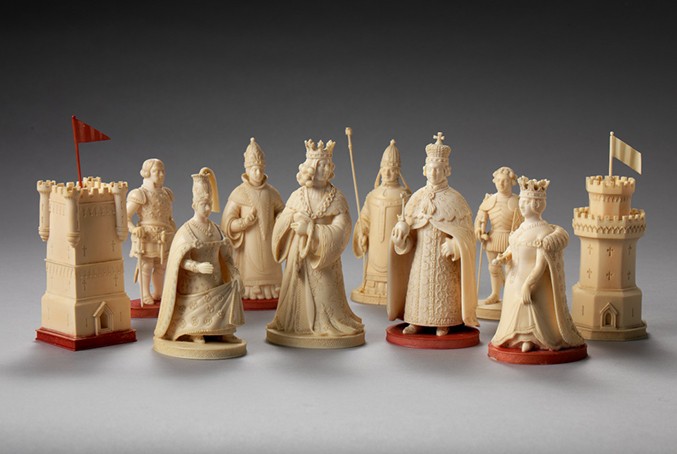
Royal Court Ivory Set, Mid-19th Century
Great Britain
Ivory
King: 4 1/2 in.
Photo © Bruce M. White, 2013
Gracefully posed figures wearing flowing drapery animate this lovely chess set which depicts two medieval European courts. The king on the red side holds an orb topped by a cross, a symbol of Christ’s dominion over the earth, and a symbol of power for rulers. The bishop on his side holds up two fingers in a gesture of blessing. The white king has an elaborately decorated robe and delicately carved curly hair. The pawns for the two sides hold swords and spears, and the knights wear fifteenthcentury armor. This set was featured in the January-April 1904 issue of Connoisseur Magazine, a periodical for collectors of fine art and antiques.
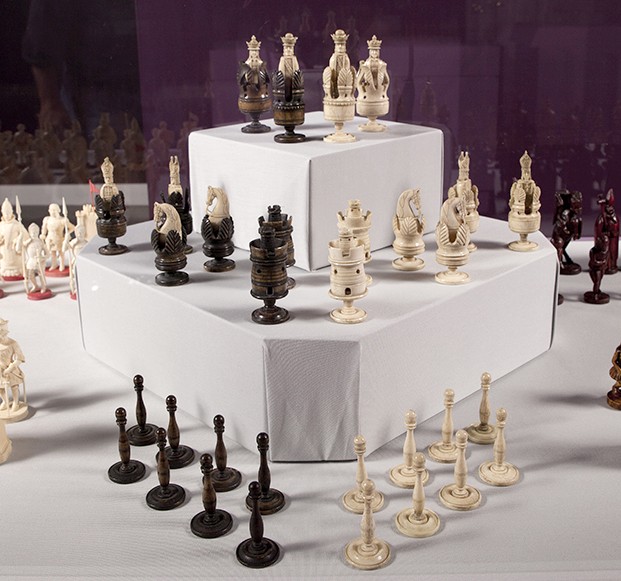
Pulpit Set, Early 19th Century
Great Britain
Bone
King: 4 in.
Photo © Michael DeFilippo
Platforms with acanthus leaf embellishments support half-length figures with grim expressions in this chess set made of bone. Once thought to have been created in Spain, pulpit sets are now considered to have been produced in England by French prisoners captured during the Napoleonic Wars. Some sets have figural decoration, like this one, while others feature more abstract representations of kings, queens, and bishops.
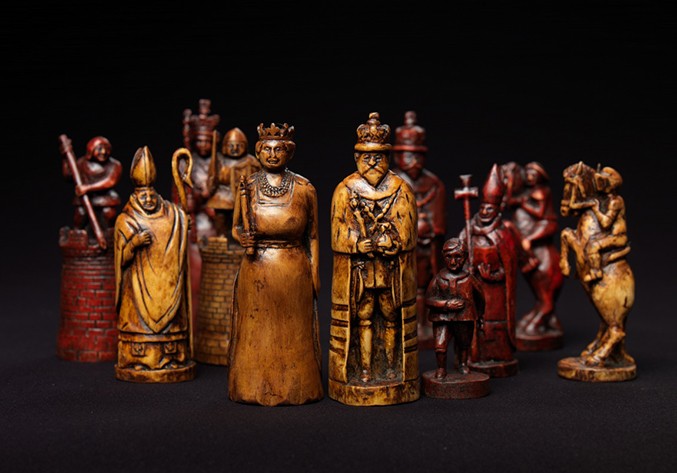
English Carved Hazelwood Set, Early 20th Century
England
Hazelwood
King: 5 in.
Photo © Bruce M. White, 2013
The individualized features of the figures in this English carved hazelwood set testify to the high level of craftsmanship necessary to carve it. The close attention to detail may indicate that the figures were meant to represent specific characters from a story. The rooks protect their towers with swords and spears, while the bishops have both highly differentiated dress and various staffs and crooks. On the red side, where the pawns are represented by young boys of various heights, the queen appears to be the dominant figure, elevated both by her stature as the tallest piece and her pose holding an orb topped by a cross. The king may be a representation of the English King Edward VII.
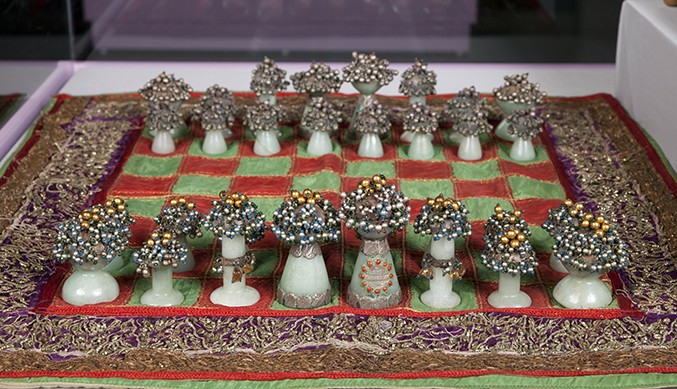
Bundi Jade and Silver Chess Set, 1864
India
Jade with silver applications and balls, textile board
King: 3 1/4 in. Board: 22 1/4 x 22 1/4 in.
Photo © Michael DeFilippo
This extraordinary jade chess set is displayed with its original textile board with green and red squares surrounded by an elaborately decorated purple border. The pieces are abstract forms topped by beads and silver and gold plated balls. The expensive materials and beautiful workmanship are testaments to the taste and wealth of the set’s owner. The kings bear silver applications with inscriptions. One king has a message written in Devanagari script, an alphabet used in India and Nepal, while the other has an Urdu inscription in Arabic script. These each name leaders–the Devanagari script names Maharao Shri Jaimalji, and also includes Samvat (year from the Hindu calendar) 1920, which corresponds with the year 1864 A.D.
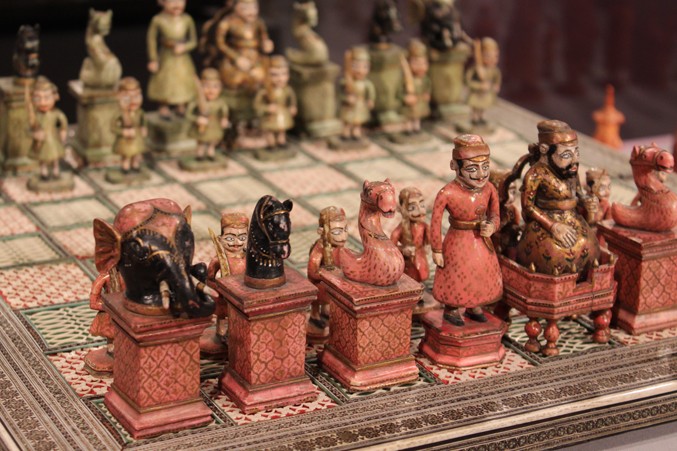
Rare Rajasthan Set, Early 19th Century
Indian
Ivory Filigree Board, Mid-19th Century
Pieces: India; Ivory; King: 4 in.
Board: India; Ivory and metal; Board Size: 18 1/4 x 18 1/4 in.
Photo © Bailey Dolenc
This unique set, executed in shades of apricot and green, was created in Rajasthan, a state located in the northwestern region of India. Its rarity stems from its hybrid style. While the kings, queens, and pawns resemble those in traditional Rajasthan-style sets, the bishops, knights, and rooks are camels, horses, and elephants, similar to those found in Sikh or Sahib-style sets. The pink color of one side may allude to Jaipur, the capital city of Rajasthan, which was nicknamed “The Pink City.” Applied gold decoration in floral and geometric patterns enlivens the surfaces of the king and advisor’s garments, as well as those of the pedestals that support busts of camels, horses, and elephants. The pawns before them stand with weapons and shields ready for battle. The set is displayed on an ornate early nineteenth-century filigree folding chess board, which was also produced in India.
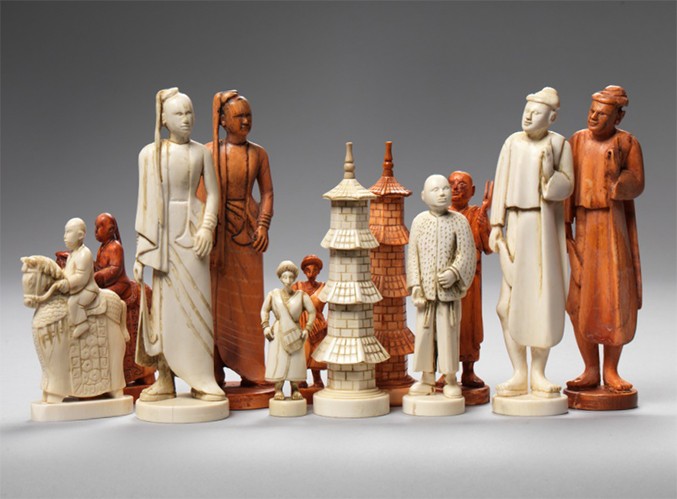
Javanese Ivory Chess Set, 19th Century
Java, Indonesia
Ivory
King: 5 3/4 in.
Photo © Bruce M. White, 2013
With 135 million inhabitants, Java is the world’s most populous island and home to Indonesia’s capital, Jakarta, making it a hub of Indonesian history and culture. This set incorporates elements of Javanese life into the standard arrangement of chess pieces, featuring a king and queen in traditional royal dress, standing dignitaries in place of bishops, and tiered pagodas as rooks.
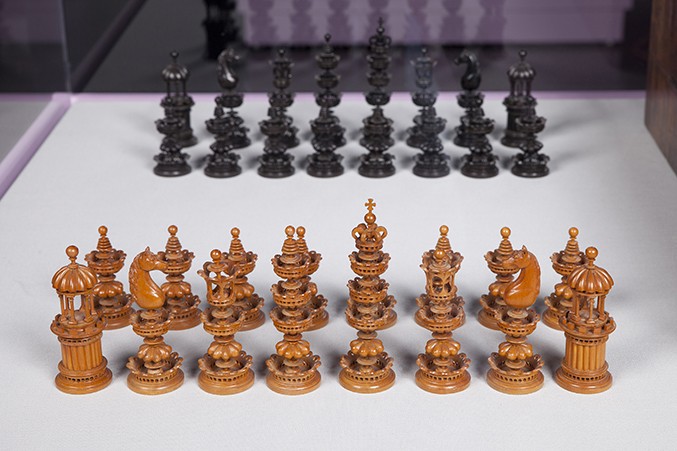
Edel Style German Wooden Set, Mid-19th Century
Germany
Wood
King: 4 1/4 in.
Photo © Michael DeFilippo
Floral motifs abound in this set, which has tiered decorations of open buds on its pieces. It is made in the style of Michael Edel, a designer and creator of chess sets who lived in Munich, Germany, in the nineteenth century. The rooks, which resemble the bell towers of churches, are characteristic of his work. Sets like these were turned and carved in multiple parts, then assembled by a craftsman.
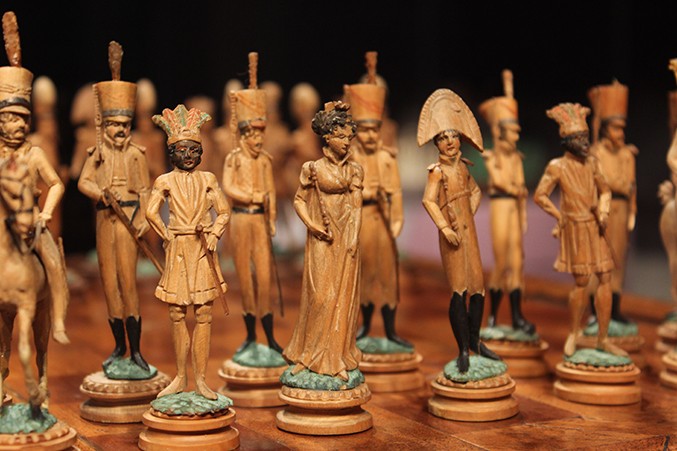
German 19th-Century Wooden Military Set, Mid-19th Century
Germany or Austria
Wood
King: 3 3/4 in.
Photo © Bailey Dolenc
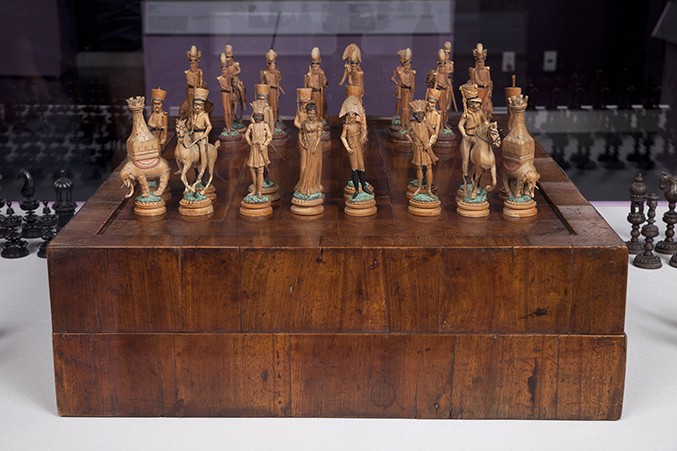
German 18th Century Chess Box, 18th Century
Mahogany, walnut, and satinwood
21 x 21 in.
Photo © Michael DeFilippo
This naively carved military chess set may depict a military conflict between the French and Austrians. One side likely represents the famed French Emperor Napoleon and the Empress Josephine, while the other may represent the forces of Frances II, the Holy Roman Emperor and first Emperor of Austria. The rooks, turrets supported by elephants, may refer to Napoleon’s campaigns in North Africa, as might the bishops who resemble “Mamluks” or enslaved soldiers. Unlike most other chess sets, the pawns stand taller than many of the other pieces. Each of the figures stands on a painted bed of green grass. This set is shown on a German eighteenth-century chess box. The box is also designed so that its owner could use it to play other games, like tric-trac, backgammon, or Nine Men Morris.
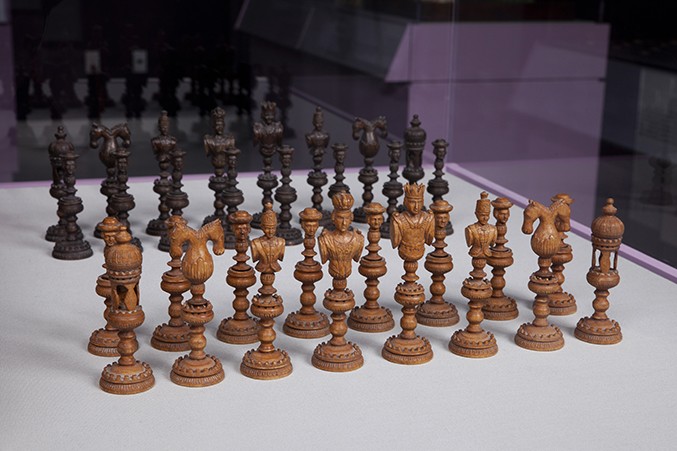
German Wooden Double-headed Knight Set, 19th Century
Germany
Wood
King: 4 in.
Photo © Michael DeFilippo
The double-headed knights in this set are characteristic of a regional style of chess set that flourished in lands ruled by the Habsburg Empire, as well as Germany, in the nineteenth century. They were produced by numerous craftsmen living in the region, and often featured figural pawns that represent the peasantry, as in this set. The double-headed knight was so closely associated with chess sets from this region that the Hanover Turner’s Guild, an association of artisans in the city of Hanover, Germany, illustrated it on their seal.
Artifacts Featured in the Exhibition: Played
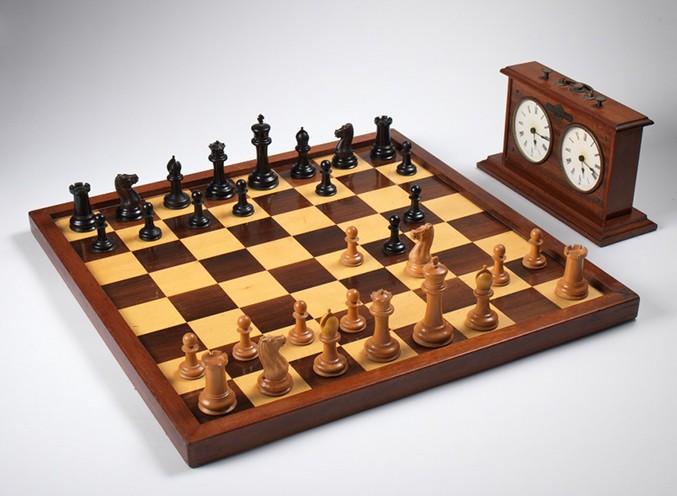
Jaques 1849 Early Staunton Set, Large Antique Chess Board, and Jaques Antique Chess Timer Pieces, 1849
London, England
Ebony and boxwood
King: 4 1/4 in.
Board: 1850-1900; England; Mahogany, rosewood, and satin-birch; 24 x 24 in.
Timer: 1895; England; Wood, metal; 9 1/2 x 2 1/2 x 7 in.
Photo © Bruce M. White, 2013
Staunton sets represented the culmination of an effort to create standardized chess sets for play in tournaments. Before Staunton sets, multiple styles of chess sets proliferated, even within the same country. Designed to be easily recognizable by players from countries around the world, the simple pieces are differentiated both by size and design.
The set was endorsed by Howard Staunton, whose signature can be seen on the box for this set. This is a very early version of the Staunton set. It has its original hand-signed and numbered label.
Nathaniel Cooke, an architect, created the iconic design, while his brother-in-law, John Jaques, manufactured the sets. Cook found inspiration in Greek and Roman architecture. He based the design of the knight in the set upon the horse pulling the chariot of the moon goddess, Selene, in the Elgin Marbles. The Elgin Marbles were sculptures from the famous temple of the Parthenon in Athens, Greece, and had recently been taken to London.
As the producer of the famous Staunton chess set, Jaques of London was a leading chess manufacturer beginning in the nineteenth century. While in earlier centuries, chess games had no time limit, by the 1880s, time controls were widespread. To accommodate this new development, Jaques and other game equipment firms began to market the two-faced chess clock.
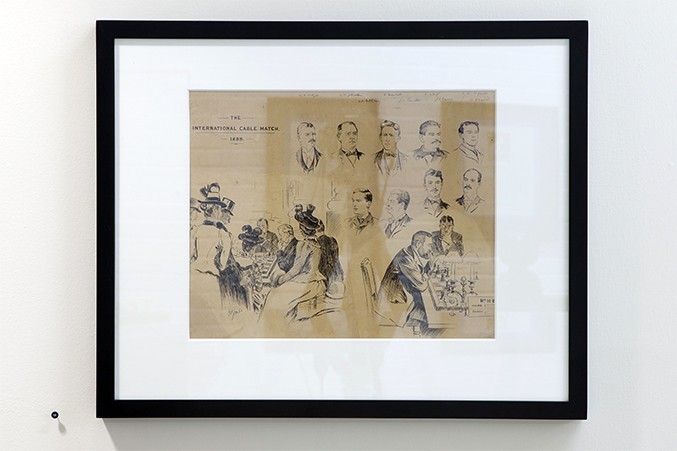
The International Cable Match 1899 Original Pen and Ink Artwork, 1899
England
29 x 12 1/4 in.
Photo © Michael DeFilippo
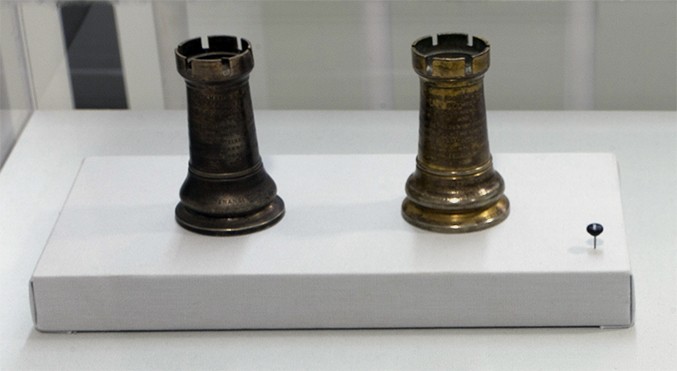
The International Cable Match 1899 commemorative trophy rooks, 1899
England
3 in.
Photo © Michael DeFilippo
These commemorative rooks and pen and ink drawings were created for the 1899 International Cable Match between the United States and England. The drawings feature the names and images of the ten American players, including Frank Marshall, Harry Nelson Pillsbury, and Jackson Showalter. This series of annual matches began in 1896 and the United States won this match by a score of 6-4, tying the series at two matches each.
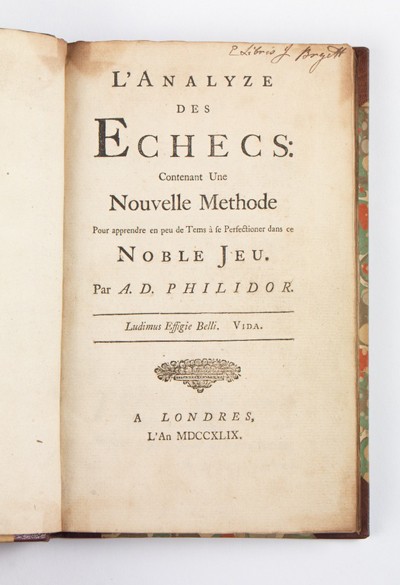
A.D. Philidor
L’analyze des E’checs, 1749
France (published in London)
8 x 10 1/4 in.
Photo © Bruce M. White, 2013
In 1749, François-André Danican Philidor, a French composer and chess player, published L’analyze des E’checs, which became the most important chess book of at least the next century. Some modern chess scholars estimate that Philidor was the best chess player in the world for 50 years; among his admirers and friends were Benjamin Franklin, Thomas Jefferson, and the French philosophers Voltaire and Jean-Jacques Rosseau.
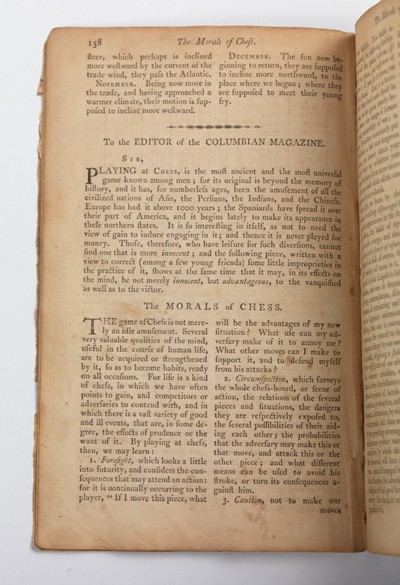
James Humphreys
Chess Made Easy, 1802
Philidelphia
5 1/2 x 7 in. (open)
Photo © Bruce M. White, 2013
Chess Made Easy was the first book on the subject published in the United States. It includes Franklin’s 1786 essay “The Morals of Chess”, basic instructions, and an analysis of the play of François-André Danican Philidor and Alexander Cunningham, two strong players of the period. Franklin’s early contributions to, and support of, American chess led to his induction into the U.S. Chess Hall of Fame in 1999.
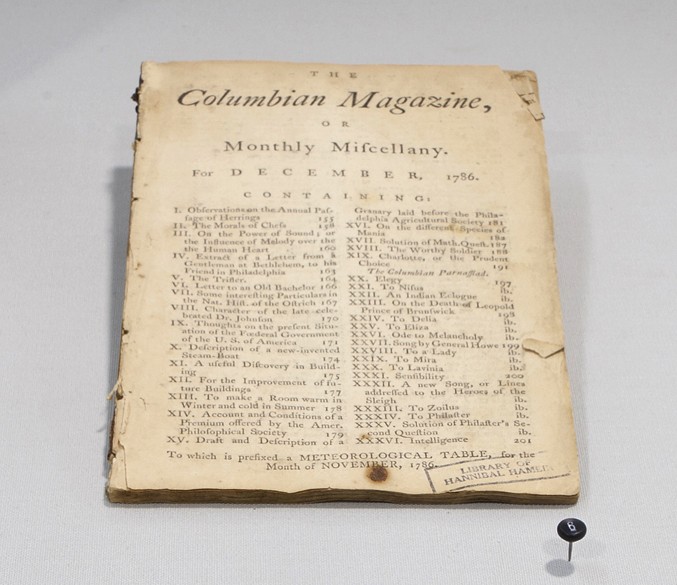
Benjamin Franklin
The Morals of Chess, 1786
New York, NY
7 1/2 x 10 1/4 in.
Photo © Michael DeFilippo
Benjamin Franklin’s essay “The Morals of Chess” represents one of the first published chess writings in North America, appearing in the December 1786 edition of The Columbian Magazine. Franklin was an avid chess player, particularly during his time in France, and became convinced of the game’s benefits. “Several very valuable qualities of the mind,” he writes, “useful in the course of human life, are to be acquired or strengthened by [chess], so as to become habits, ready on all occasions.”
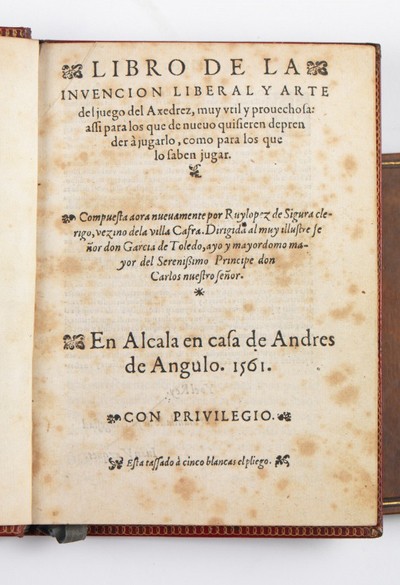
Ruy Lopez
Libro de la Invención Liberal y Arte del Juego del Axedrez, 1561
Alcalá de Henares, Spain
7 3/4 x 11 1/2 in.
Photo © Bruce M. White, 2013
Rodrigo (Ruy) López de Segura was a Spanish priest and later bishop. He authored this book in 1561; it was one of the first published tomes about modern chess in Europe. It was translated into English as Book of the Liberal Art and Invention of the Game Chess. The book consists of four parts: an introduction to the history and rules, a section on openings and two sections of criticism on the games of an earlier chess author, Pedro Damiano. The Ruy Lopez opening was named after one of the openings he examined in this book.
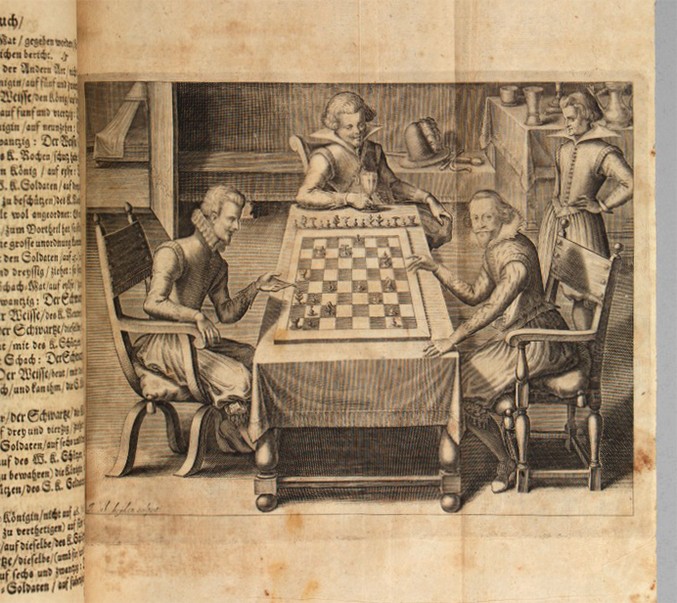
Selenus
Das Schach oder Konig-Spiel, 1616
Germany
11 1/2 x 16 1/2 (open with foldout)
Photo © Bruce M. White, 2013
Two men play chess while their friends look on in this illustration by artist Jacob van de Hayden. The man gazing at the viewer with his hand raised, ready to pick up a piece, is the author of the book. Augustus the Younger, Duke of Brunswick-Lüneberg, used the pen name Gustavus Selenus to write this history of the game of chess. Though the content is indebted to Ruy López‘s Libro de la Invención Liberal y Arte del Juego del Axedrez, the book also contains a history of chess and beautiful illustrations. The foldout illustration includes a central European style of set that became known as a Selenus set, after the author of the book.
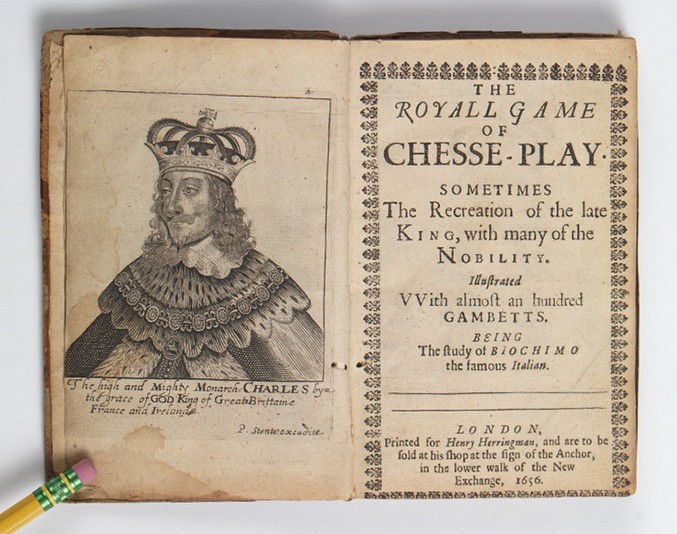
Greco
The Royall Game of Chesse-Play, 1656
London, England
6 x 7 1/2 in.
Photo © Bruce M. White, 2013
The Royall Game of Chesse-Play was written by one of the first professional chess players, Gioacchino Greco. Greco is remembered for his bold, attacking, tactical style of play, and in his book he analyzed how these techniques could be used to break down an opponent’s position.
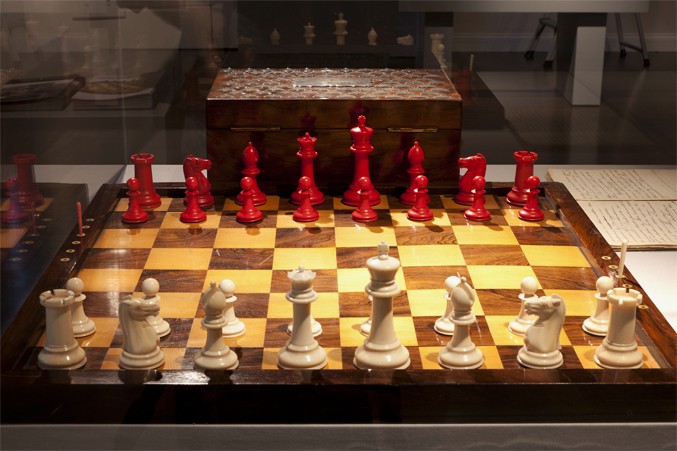
Tees-Side Chess Association Annual Trophy Set, c. 1885
England
Ivory with rosewood board
King: 4 1/4 in. Board: 23 1/2 x 23 1/2 in.
Ledger: 13 1/2 x 8 3/4 x 1/2 in.
Photo © Michael DeFilippo
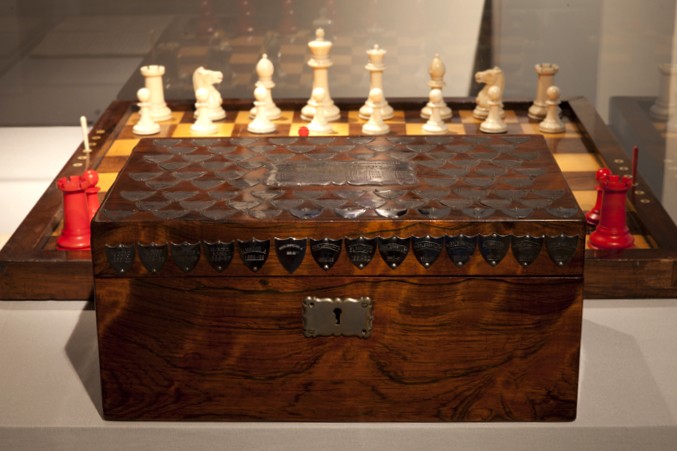
Tees-Side Chess Association Annual Trophy Set, c. 1885
England
Rosewood box with metal shields
Box: 13 x 9 x 5 3/4 in.
Photo © Michael DeFilippo
The Tees-Side Chess Association was formed in 1883 in an effort to connect a number of smaller clubs throughout northeast England’s Cleveland County. This Staunton set with its accompanying box and wooden board, manufactured by Jaques of London, was the club’s annual trophy to each year’s winning club. The metal plaques on the top and front side of the box’s lid indicate the town club that won the Association’s Challenge Trophy between 1886 and 2003. The board has peg-holes on the side where pegs could be placed to keep track of wins and losses.
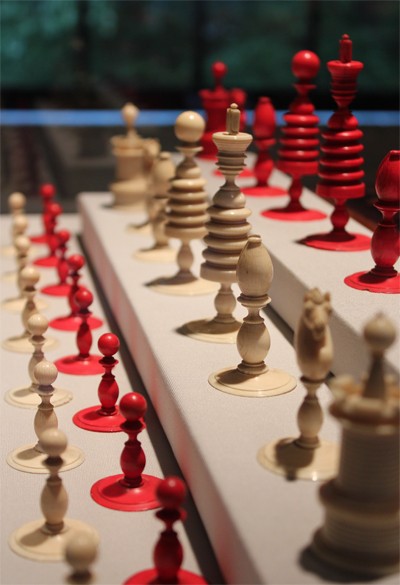
Old English Ivory Chess Set, c. 1800-1825
England
Ivory
King: 4 in.
Photo © Bailey Dolenc
This Old English Ivory Chess set is an example of one of the many regional styles of playing sets that flourished in England before the conventionalization of pieces in the mid-nineteenth century. The king is topped by a Maltese cross; both it and the queen have stems ornamented with stacks of disc shapes. Ivory chess sets like this one were meant for wealthier customers than the more common wooden playing sets.
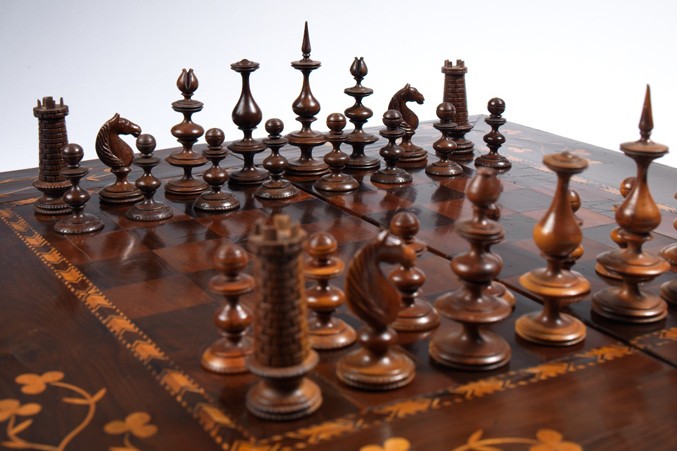
Irish Killarney Set, c 1875
Ireland
Arbutus and yew wood
King: 4 in.
Photo © Bruce M. White, 2013
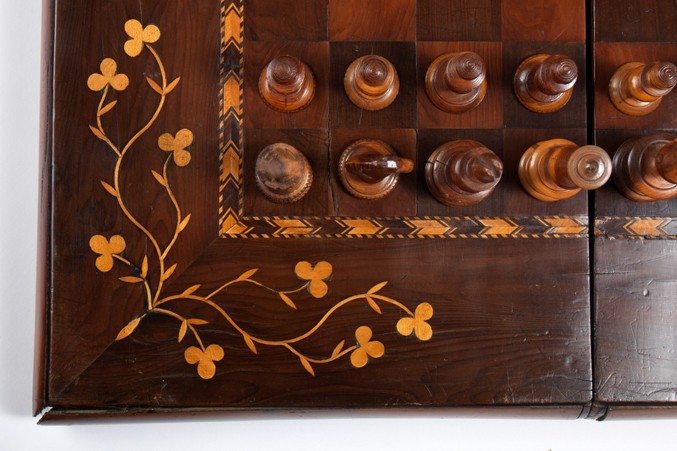
Killarney Chess Board, c 1875
Ireland
Wood 20 x 20 in.
Photo © Bruce M. White, 2013
This chess set and board were crafted in Killarney, located in southwest Ireland, for the burgeoning tourist trade, which began in the mid-1700s when local nobility developed the area as an Irish answer to England’s Lake District. To this day, tourism remains by far the city’s largest industry. The set is an example of “Killarneyware,” a term given to furniture and other artwork from the region that shares the same distinctive style. The shamrock designs around the edge of the board, as well as the use of arbutus and yew wood for the board and pieces, are typical of the area.
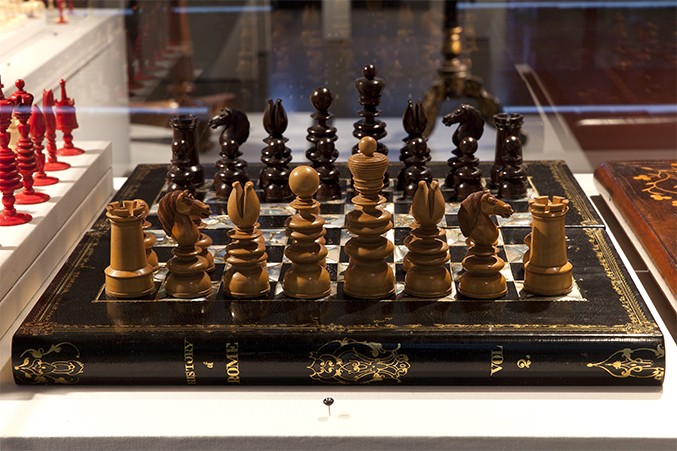
Large Antique St. George Set, c. 1825-1850
England
Boxwood and rosewood
King: 5 in.
Photo © Michael DeFilippo
One of the many styles of playing sets that were produced in England, this set is named for St. George’s Chess Club in London. The Club gained fame for attracting some of the best chess players of the nineteenth century, including Howard Staunton. It also sponsored the first international chess tournament in 1851, the same year as the Great Exhibition in London. One knight from each side has a small dot on its head to signify king’s side. The set is paired with an ornate mother-of-pearl chess board, which is decorated to resemble a book detailing the history of Rome.
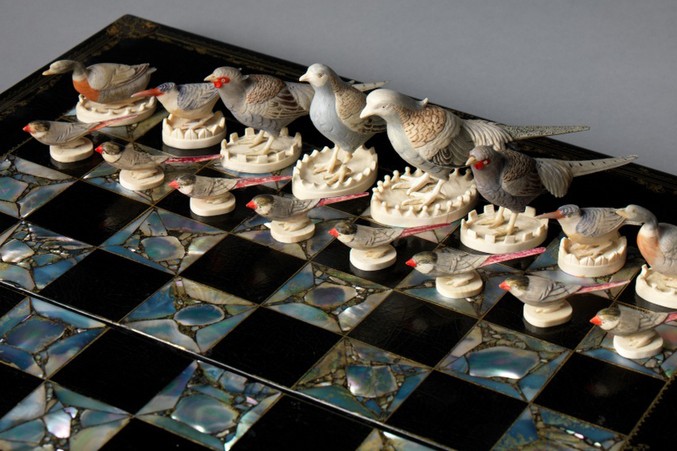
Mother of Pearl Chessboard, c. 1850-1900
Great Britain
Wood, mother-of-pearl
20 1/2 x 18 in.
Photo © Bruce M. White, 2013
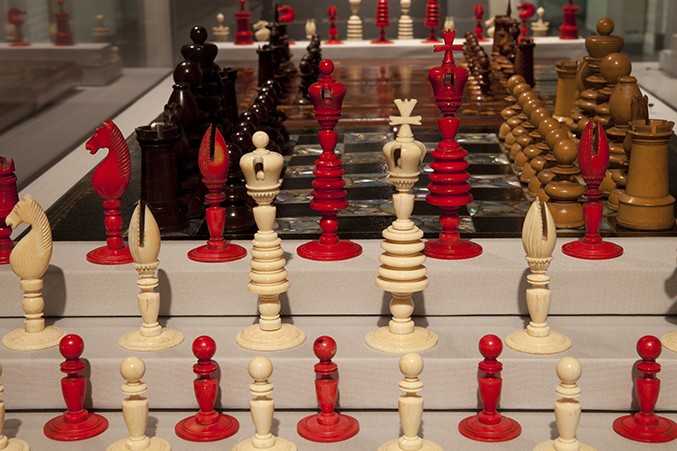
Tall Ivory Chess Set, Late 18th or early 19th Century
England
Ivory
King: 5 in.
Photo © Michael DeFilippo
Though the style of this set is standard, the ivory material it was manufactured from makes it more upscale than some of the wooden sets in the gallery. The style of the knights indicates that the set was likely manufactured in the London workshop of John Calvert in the 1790s.
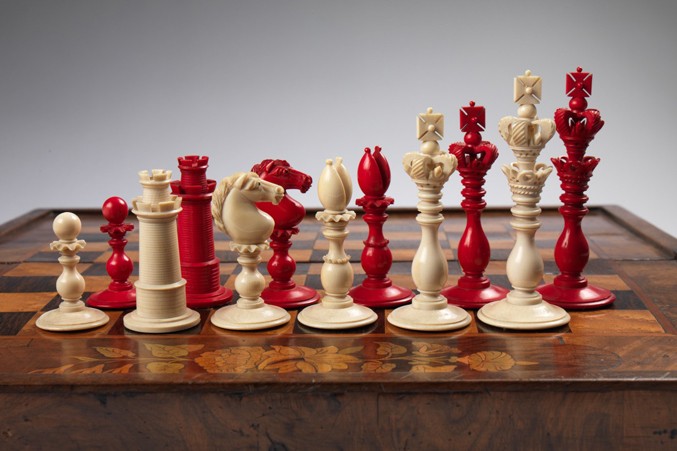
Calvert Ivory Decorative Chess Set, c. 1825-1850
English Walnut Board-Box, c. 1850-1875
Pieces: England; Ivory; King: 4 3/4 in.
Board-Box: England; Walnut; Board: 19 3/4 x 17 3/4 in.
Photo © Bruce M. White, 2013
In 1791, John Calvert established a business manufacturing chess sets in London. This set was likely created after his widow, Dorothy, started running the business in 1822, as the knights match others produced in her workshop. Made of ivory and featuring more elaborate decoration, this set may have been intended for a wealthier clientele than the other Calvert set on display in this gallery. The set is displayed on a gorgeous wooden board-box, which also could be used to play backgammon. Marquetry decorations, or thin layers of wood veneer, in the forms of summer flowers ornament the board’s border.
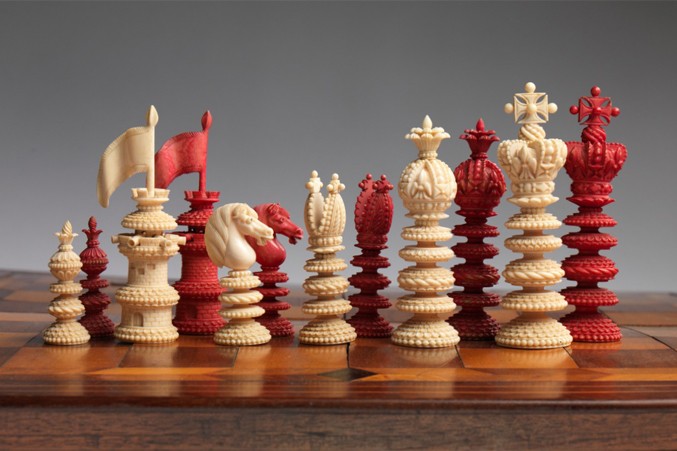
Hastilow Set, Mid-19th Century
England
Ivory
King: 5 in.
Photo © Bruce M. White, 2013
This set may have been made by the famed English carver of chess sets, Charles Hastilow. Hastilow was known as a masterful carver of ivory, and one of his sets was included in the 1862 International Exhibition. Though this is a playing set, it features elaborate petaled decoration. The rooks are cannon towers topped by waving flags and the kings have crowns topped by Maltese crosses.
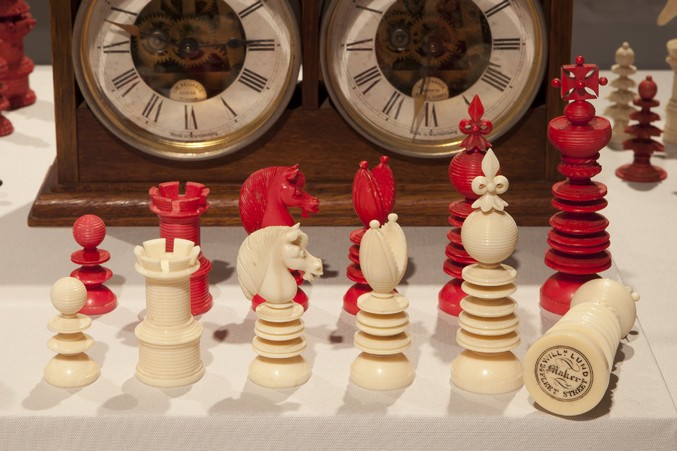
Lund Stamped Large Ivory set, Mid-19th Century
England
Ivory
King: 4 1/4 in.
Photo © Michael DeFilippo
The underside of the base of the white king in this set displays the stamp of set’s maker, William Lund of London. William Lund had an address on Fleet Street, and had also taken over his father Thomas’s business on Cornhill after his death. The Fleet Street address is stamped on the bottom of the king in this set. This charming, large set features grooved decorations on the pieces. The stems of all the pieces save for the rook are made of tiers of disks, and the queens are topped with bows.
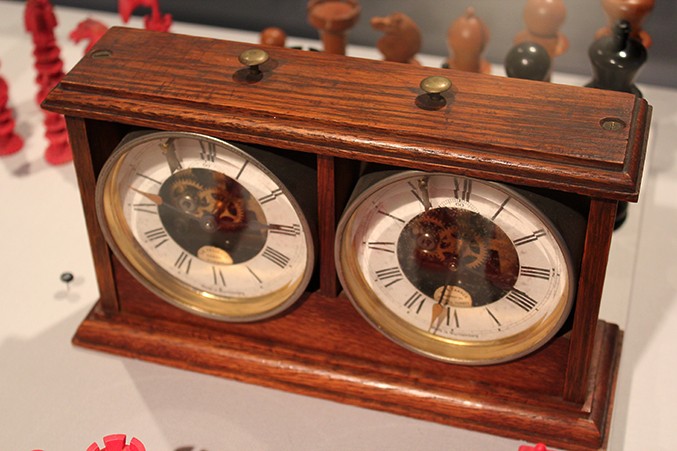
Tanner Chess Timer, c. 1900
England or Germany
Wood, metal
10 1/2 x 3 1/4 x 6 1/4 in.
Photo © Bailey Dolenc
Tanner clocks were considered an elite tournament clock and a rival to those of the Jaques Company, whose chess equipment dominated the market in the late nineteenth century. W.H. Tanner manufactured his clocks out of his factory in Redhill, a suburb of London. Tanner clocks were acclaimed for their reliability and accuracy.
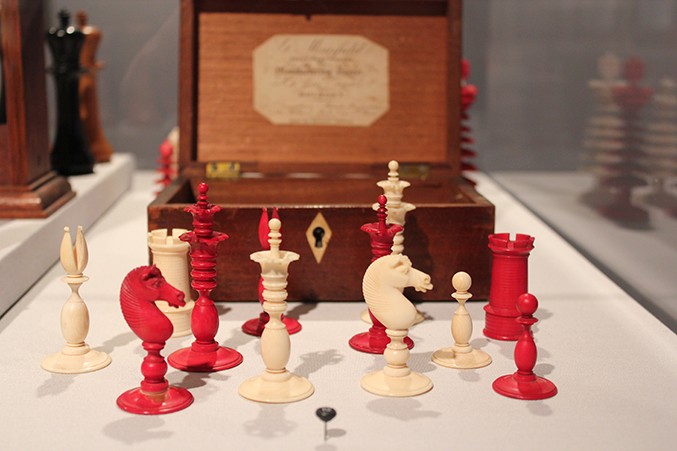
Merrifield Ivory Set and Stamped Box, c. 1825-1850
England
Ivory
King: 3 1/4 in. Box: 7 x 4 3/4 x 6 1/4 in.
Photo © Bailey Dolenc
Made by George Merrifield, this set gains its name from another English manufacturer of chess sets, John Calvert. Calvert popularized sets of this type, which were then produced by several other English manufacturers, including Lund, Jaques, and Fisher. Early Calvert style sets are known for the petalled tops of their kings and queens, which may be descended from the stylistic qualities of Selenus style sets.
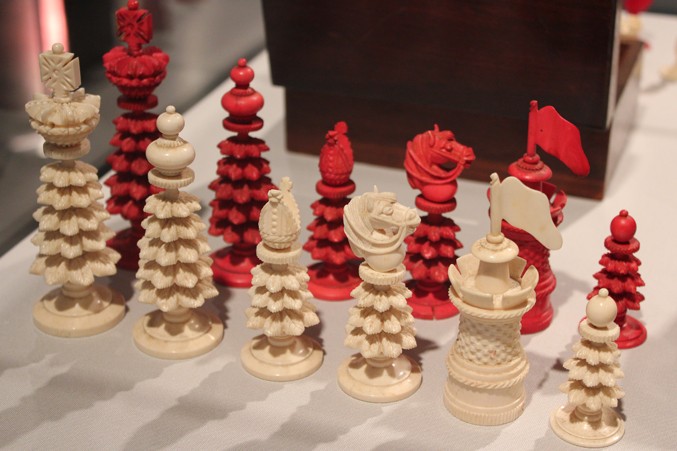
Bone Petal Set, Mid-late 19th Century
Possibly Chinese
Bone
King: 4 3/4 in.
Photo © Bailey Dolenc
Embellished by layers of leaves or petals, the stems of this distinctive playing set resemble trees or bushy plants. The knights are also uncommon, showing horses wearing bridles and reins, a nod to features in figural ornamental chess sets and the military associations of the game of chess. This set may have been made in China for a western patron.
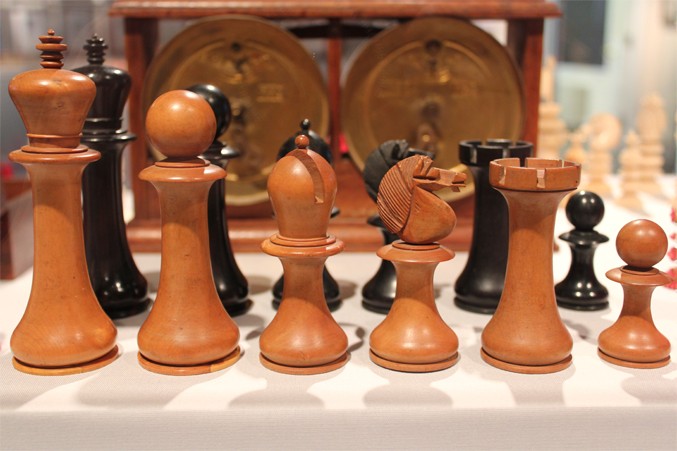
Dublin Wooden Set, c. 1850-1900
Ireland
Wood
King: 5 in.
Photo © Bailey Dolenc
The oversized, chunky pieces in this set are very simple in form. This design allowed them to be easily mass produced through woodturning—the only piece that required significant carving was the knight. Sets of this design appear in the pattern book of English chess set maker Jaques of London.
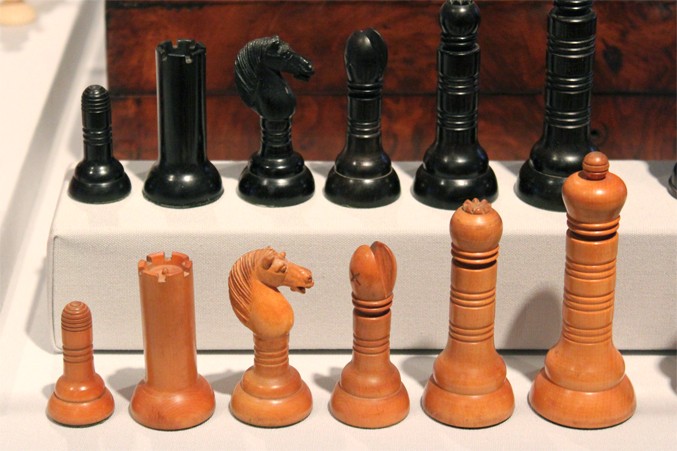
Philidor chess set by Merrifield, c. 1850
England
Boxwood and ebony
King: 3 3/4 in.
Photo © Bailey Dolenc
The Philidor chessmen, named after eighteenth-century composer and chess player François-André Danican Philidor, were introduced in 1850 to compete with the Staunton style as the set of choice among tournament players. Unfortunately for its creator, George Merrifield, it was a failure and manufactured for only about a year, and only three sets of this kind are now known to exist.
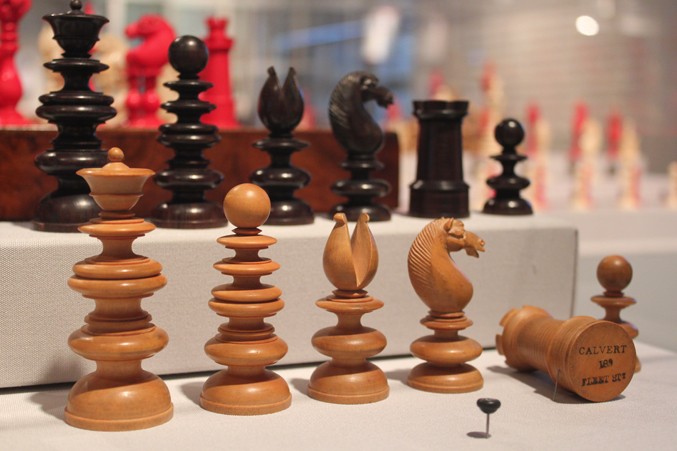
Calvert Wooden Stamped Set, 1800-1825
England
Wood
King: 3 1/2 in.
Photo © Bailey Dolenc
This wooden set, crafted by the firm of John Calvert of London, is stamped on the bases of the two white rooks with the company’s address, 189 Fleet Street. A leading designer of chess sets in the late eighteenth and early nineteenth centuries, Calvert was a Master of the Worshipful Company of Turners, a trade association for craftsmen who turned and shaped wooden objects on a lathe. An ivory Calvert style set is also on view in this gallery.
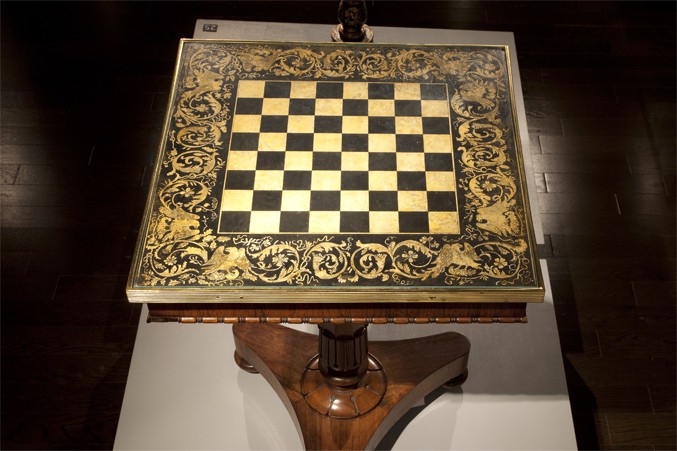
Miles & Edwards Chess Table, 1835
England
Rosewood and penwork
22 x 22 x 29 1/4 in.
Photo © Michael DeFilippo
This rosewood and penwork chess table was produced by Miles & Edwards, an early nineteenth-century firm that sold fabric, curtains, wallpaper, and other home furnishings. Eagles with prey and trailing foliage ornament the edges of the board. Based on the address stamped on the underside of the table base, 134 Oxford Street, this table can be dated to the mid-1830s.
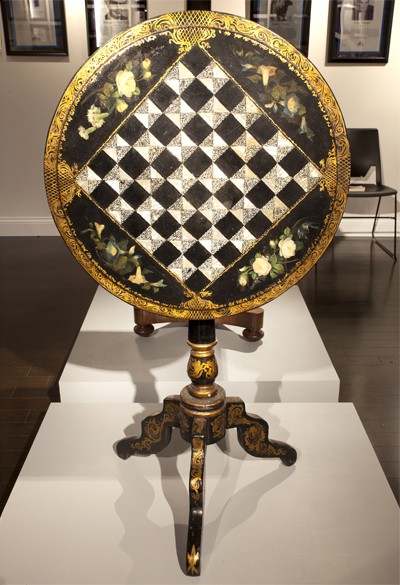
Early Victorian black lacquer papier-mâché games table, c. 1825-1850
England
Papier-mâché with black laquer and mother-of-pearl
23 1/2 x 23 1/2 x 31 1/2 in.
Photo © Michael DeFilippo
This tilt-top chess table is decorated with black lacquer and papier-mâché. While today papier-mâché is more often associated with sculpture or other three-dimensional artworks, it was a popular material for Victorian furniture due to its light weight and strength after baking. Finer pieces, like this one, were inlaid with mother-of-pearl, which is used for the light colored squares.
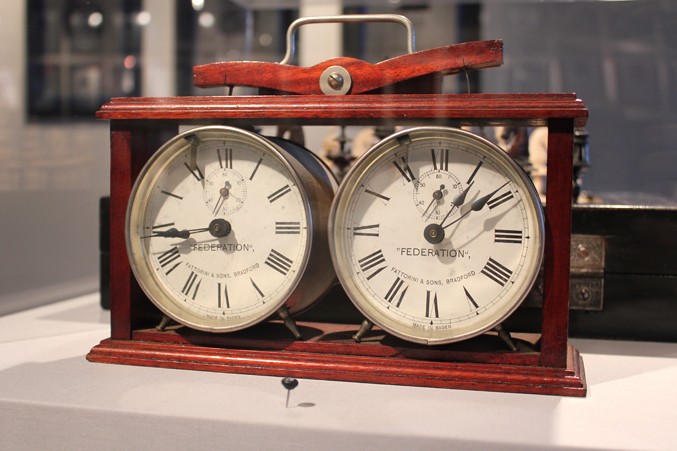
Fattorini Timer, c.1900
England
Wood, metal
9 3/4 x 3 1/4 x 7 1/2 in.
Photo © Bailey Dolenc
Fattorini and Sons, established in the early nineteenth century by a family of Italian immigrants to England, manufactured a range of products, including jewelry, sewing machines, sports trophies and medals, and, later, the first mass-produced chess clocks. Advertisements for Fattorini’s timers can be found in issues of British Chess Magazine starting in the late 1890s. Fattorini’s two-pendulum design became the standard until the advent of digital chess clocks in the late twentieth century.
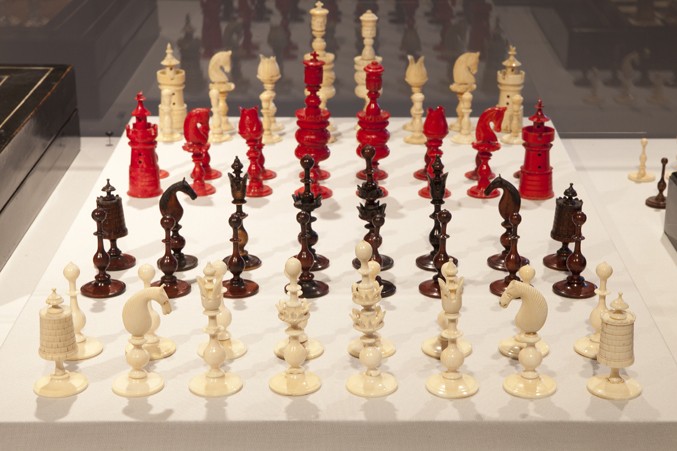
European Ivory Set, c. 1800
Central Europe
Ivory
King: 3 1/2 in.
Photo © Michael DeFilippo
This ivory set, with one side stained brown and the other left natural, features queens and kings with single- and double-tiered galleries respectively. All of the pieces sit atop baluster bases, except for the rook, which takes the form of a raised turret. The bishops’ miters are pierced by urn-shaped finials, and teardrop-shaped accents top each of the pawns.
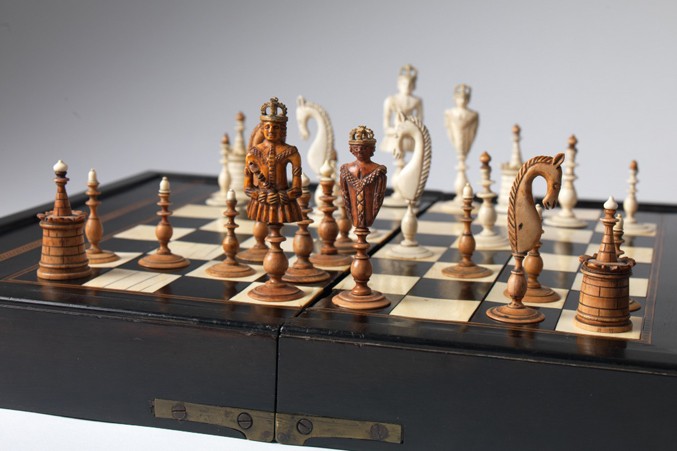
German 18th Century Bone Set, Late 18th Century
Germany
Bone
King: 4 in.
Photo © Bruce M. White, 2013
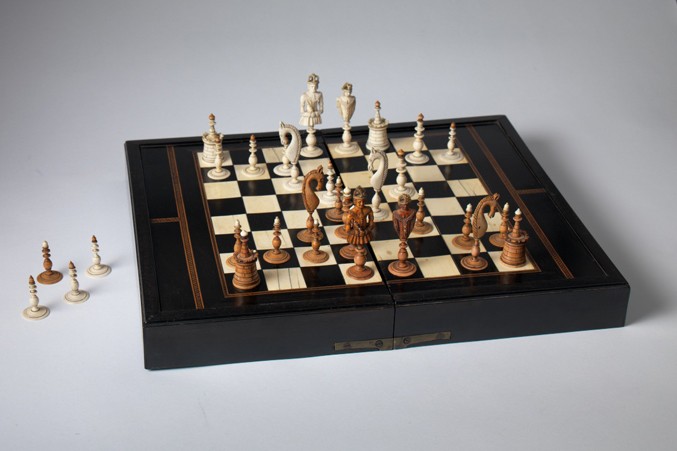
German Ivory & Ebony Inlaid Box-Board, Late 18th or early 19th Century
Germany
Ivory and ebony
18 x 14 1/2 in.
Photo © Bruce M. White, 2013
Kings holding scepters, symbols of their power, lead the two sides in this set. Made of bone, one side is left white, while the other has been stained brown. The king and queen are frontally posed. The bishops, rooks, and pawns have finials with the color of the opposite side, a decorative element commonly found in eastern European sets of the period. This set is paired with a box-board from the late eighteenth or early nineteenth century, which has an interior designed for playing the game of backgammon.
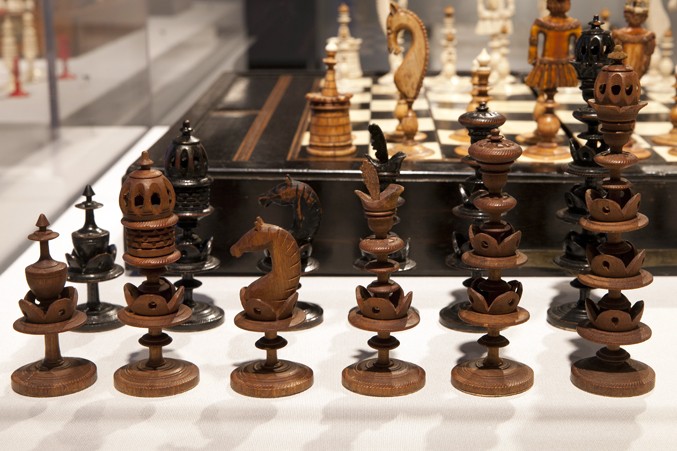
German Toy Set, c. 1875-1900
Germany
Wood
King: 5 in.
Photo © Michael DeFilippo
This set’s tiered floral decorations and the carved globes on the king, queen, and bishop bear resemblance to a more ornate version of a Selenus style set.
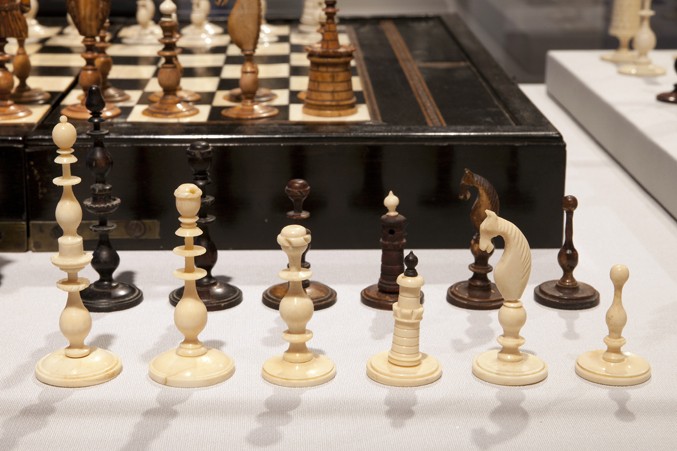
German Playing Set, Late 18th Century
Germany
Bone
King: 3 1/2 in.
Photo © Michael DeFilippo
This German set, made of natural and stained bone, may have been created in Nuremberg. The knobbed stems and abstract forms of the king, queen, and bishop are reminiscent of other nineteenth-century styles, while the dramatically arched horse’s head and the accent of opposing color on the rook adds a unique touch.
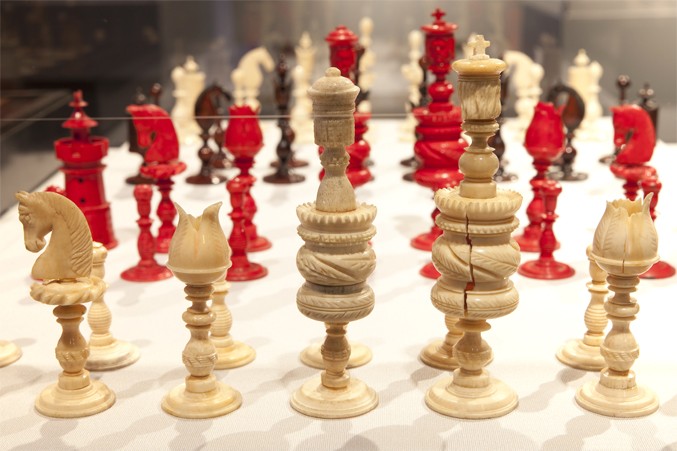
German Barleycorn Set, Mid-19th Century
Germany
Bone
King: 4 3/4 in.
Photo by Michael DeFilippo
Barleycorn sets earned their name from the leafy decorations around the barrels on the centers of the kings and queens. Though this style of chess set originated in England, it soon spread to the United States and Germany. The figural decoration in the set differentiates it from its English counterparts. There are many botanical motifs in the set–the bishops resemble tulips, while the knights are surrounded by wreaths of acanthus leaves.
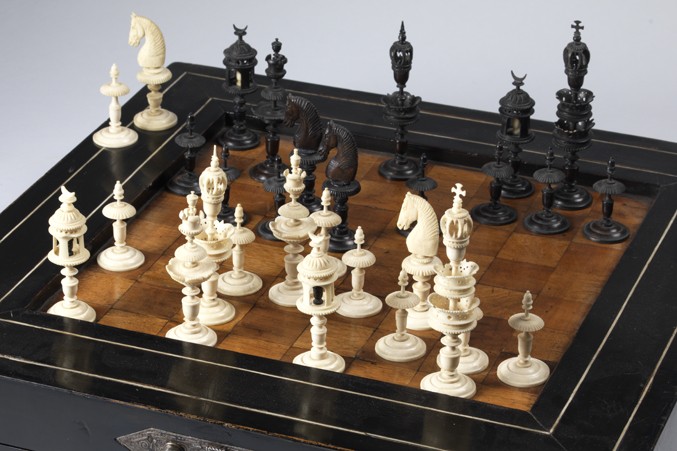
Selenus Bone and Horn Set, Mid-19th Century
Germany
Bone and horn
King: 4 in.
Photo © Michael DeFilippo
Urn motifs abound in this set, appearing on the bases of each of the pieces, as well as on the top of the bishop and inside the tower on the rook. The tiers of decoration on the kings and queens resemble open flowers or crowns. Selenus style sets resemble a set in an illustration by Jacob van de Hayden in Das Schach oder Konig-Spiel, a well-known book about chess written in 1616 by Gustavus Selenus. A copy of this book is included in the “Played” section of this exhibition as artifact number 8.
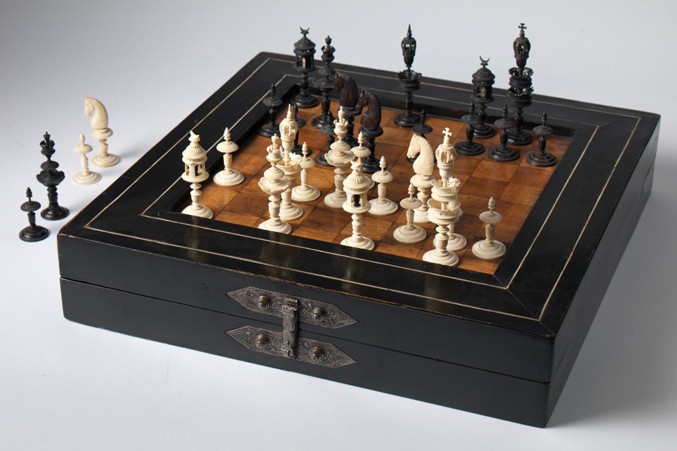
German Walnut, Fruitwood, and Ebonised Chess and Backgammon Board-Box, Early 18th Century
Germany
Walnut, Fruitwood
16 x 16 in.
Photo © Bruce M. White, 2013
The box for this set contains not only a chessboard, but also, when opened, a backgammon board. Chess and backgammon have a long association, as recognizable forms of each game emerged from neighboring civilizations—chess from India and backgammon from Persia—around the sixth century. In fact, one legend from the Persian epic poem the Shahnameh (the “Book of Kings”) states that when Indian envoys brought chess to the Persian court, the Persians taught the visitors to play backgammon in return.
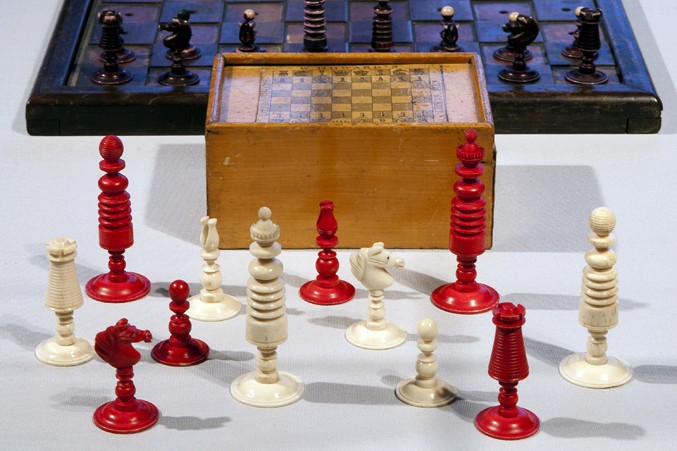
W. Howard Chess Set, Mid-19th Century
England
Bone with wooden box
King: 2 in. Box: 4 3/4 x 3 1/2 x 2 1/4 in.
Photo © Michael DeFilippo
Perhaps the most interesting feature of this small bone chess set is the mahogany storage box that accompanies it, which is engraved with the image of a chessboard and chessmen, along with the company and product name, ”W. Howard’s London Made Chess Men.” Underneath the sliding lid is written in pen, “Sarah Rosa Smyth, August 2nd, 1843,” probably indicating the set’s original owner. Sarah Rosa Smyth owned a business near W. Howard’s establishment.
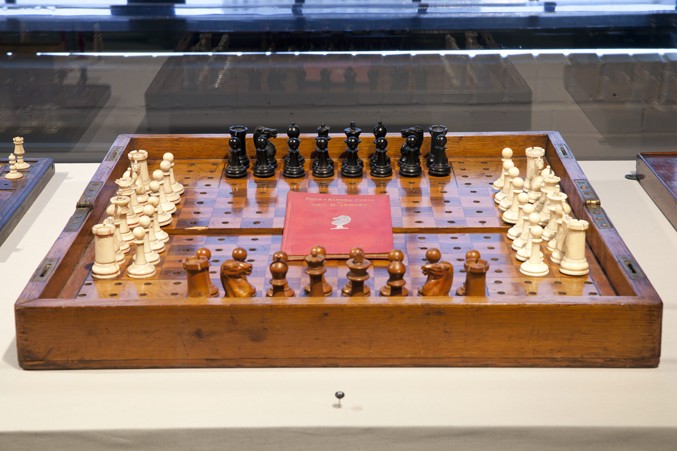
Victorian 4-Player Chess Set, 1885
England
Ivory with wood folding stand and leather case
King: 2 in.; Board: 20 x 20 in.
Instructional booklet also included
Photo © Michael DeFilippo
Variations on the traditional rules of chess have existed for centuries. In the early 1880s, Captain George Hope Verney of England published a booklet codifying the rules of a four-player chess variant known as Four Handed Chess. This particular version of chess enjoyed an enduring popularity; Verney started the Four Handed Chess Club in London, which lasted roughly half a century until World War II. This four player chess set was owned by Captain George Hope Verney.
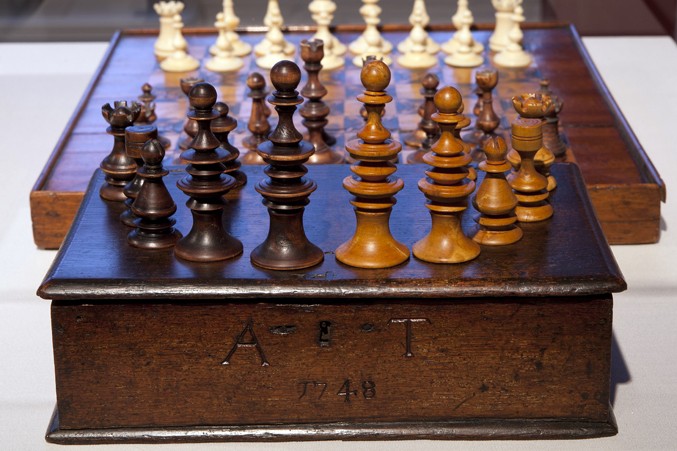
Old English Wooden Set, Mid-18th Century
England
Wood
King: 3 1/4 in. Box: 8 3/4 x 5 1/2 x 3 1/4 in.
Photo © Michael DeFilippo
The Old English style set reached the height of its popularity in the eighteenth century. This set, made of wood, is less upscale than the other Old English set in the exhibition, which is made of ivory. This set is displayed with a box that is not original to the set. The former owner of the box carved his or her initials and the year 1748 into the box’s surface.
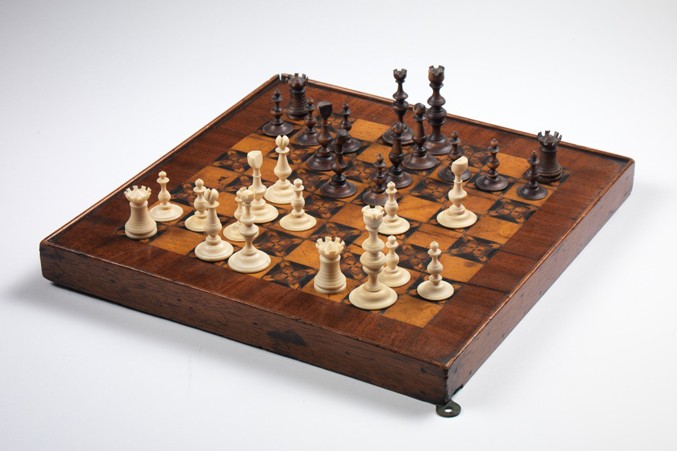
Old English Ivory Set, Mid-18th Century
English Marquetry Board, Late 18th/Early 19th Century
Pieces: England; Ivory; King: 2 3/4 in.
Board: England; Wood; Board Size: 13 1/2 x 13 1/2 in.
Photo © Bruce M. White, 2013
If Directoire and Régence were the chess set styles of choice in eighteenth-century France, the Old English set filled that role in England during the same period. The intricate design on the dark squares of the board is a craft known as marquetry, in which thin layers of wood are added to a surface to create patterns or images.
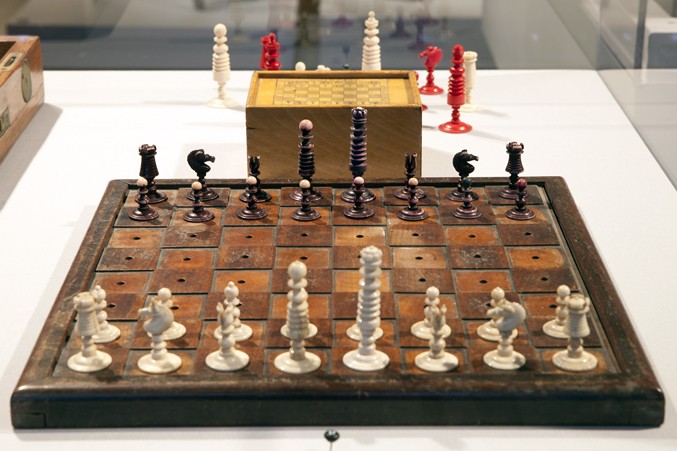
Blind Man Set, c. 1850-1875
England
Bone
King: 2 3/4 in. Board: 12 1/2 x 12 1/2 in.
Photo © Michael DeFilippo
This set is made of bone, a rarity in nineteenth-century chess sets created for blind players. The forms of the board and the chess pieces have been adapted to meet the needs of blind players. The white pieces have small knobs on the top to differentiate them from the black, and the black squares of the board are raised slightly higher than the white. The pieces have pegs on their bases that fit into holes on the boards, which would prevent them from being knocked over during play. The pieces show evidence of their use, as the stain on the tops of the black pieces has been worn by constant touching.
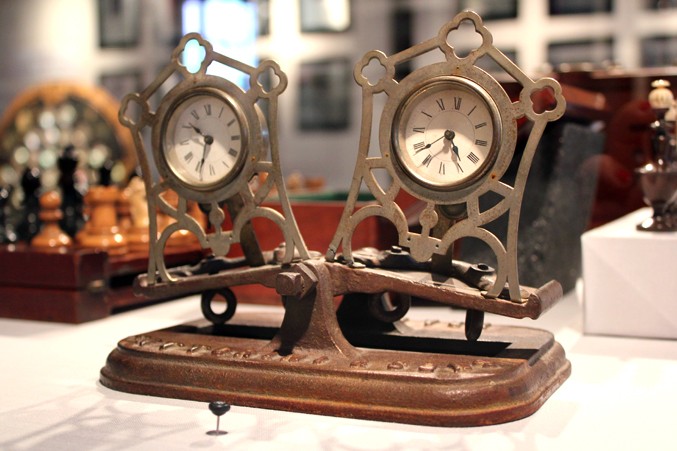
Fattorini Timer, c. 1900
England
Metal
7 1/2 x 5 x 6 in.
Photo © Bailey Dolenc
In this cast iron timer, the two clocks are mounted on a rocking platform. Made by Fattorini and Sons, the design is more ornamental than other timers of the period, in which the clock faces are generally mounted to an immobile, rectangular wooden base.
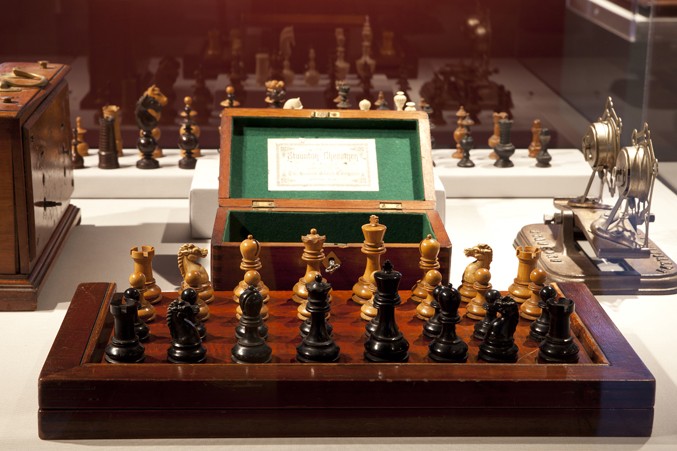
British Chess Company Wooden Chess Set, Late 19th Century
British Chess Company Folding Board, c. 1900
Pieces: England; Boxwood and Ebony; King: 3 in.
Box: 8 in. Board: England; Wood; Board Size: 16 x 16 in.
Photo © Michael DeFilippo
This ebony and boxwood set and folding board was created by the British Chess Company of Stroud, in western England. Established in 1890, the company only operated for about fifteen years, but in that time had a lasting impact. In addition to being a leading producer of sets, books, and equipment for club and major tournament play, it also collaborated with chess players to compile a regulated set of rules known initially as the British Chess Code and later, across the Atlantic, as the American Chess Code. The company’s efforts represented the first major attempt to standardize the rules of chess for a broad audience. The stamp of the British Chess Company is visible on the front of the board displayed with this set.
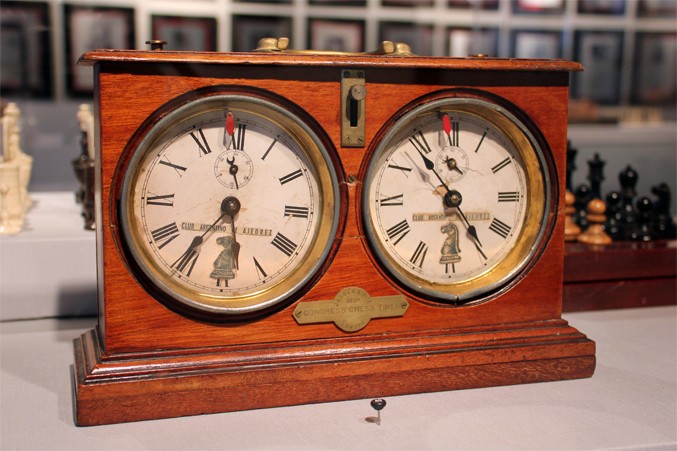
Jaques Congress Timer from Alekhine-Capablanca 1927 World Championship Match, c. 1925
England
Wood, metal
7 x 3 1/4 x 7 in.
Photo © Bailey Dolenc
This Jaques timer was used in games 7 through 16 of the 1927 World Championship match between Alexander Alekhine and José Raúl Capablanca, which was played in Buenos Aires, Argentina, from September to November of that year. The first player to win six games would be declared world champion. Alekhine, representing France, and Capablanca, representing Cuba, played 34 games before Alekhine achieved victory, with a tally of six wins to Capablanca’s three. Until the famous Fischer-Spassky contest of 1972, this titanic match was considered to be the “Match of the Century.
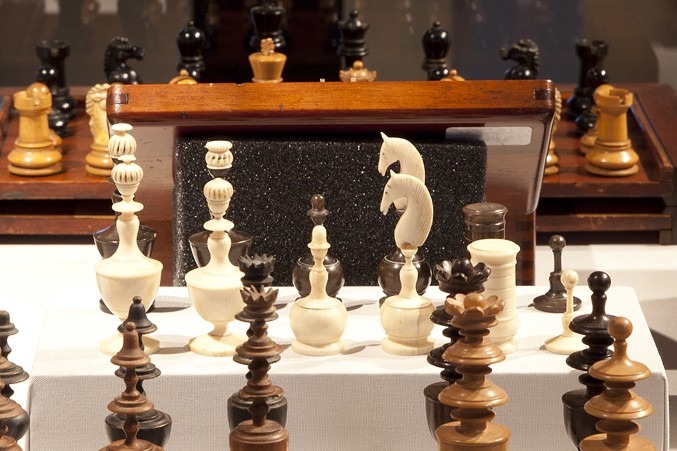
Lyon Bone Set, Late 18th or early 19th Century
France
Bone
King: 3 1/4 in.
Photo © Michael DeFilippo
Chess sets like this one, with bone trimmings and finials, are known as the Lyon style. In this case, the light pieces are made of bone and the dark pieces made of wood with bone accents; in other Lyon style sets, stained wood is used as the base material for both sides.
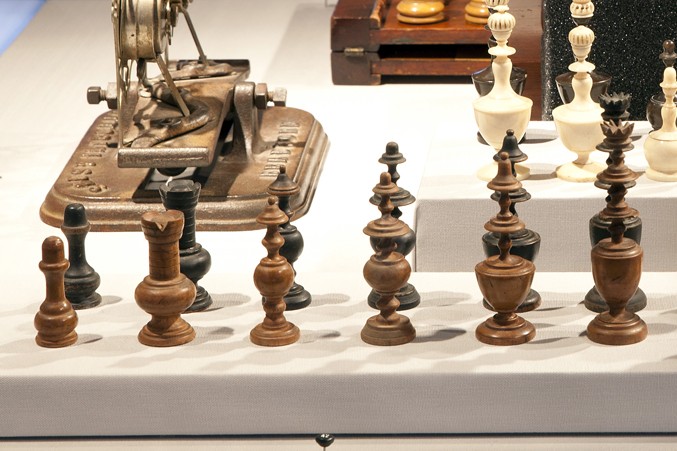
Antique Directoire Set, 18th Century
France
Wood
King: 3 1/2 in.
Photo © Michael DeFilippo
During the eighteenth century, chess flourished in France, where the emerging café culture created an environment in which people could gather to eat and drink, smoke, and play chess with friends. Directoire style sets were the most common style used in the country at this time. The sets could easily be mass-produced, as they did not contain figural knights, and therefore a master carver did not need to be employed by the company. Directoire sets were forerunners of another popular French style of chess set, Régence.
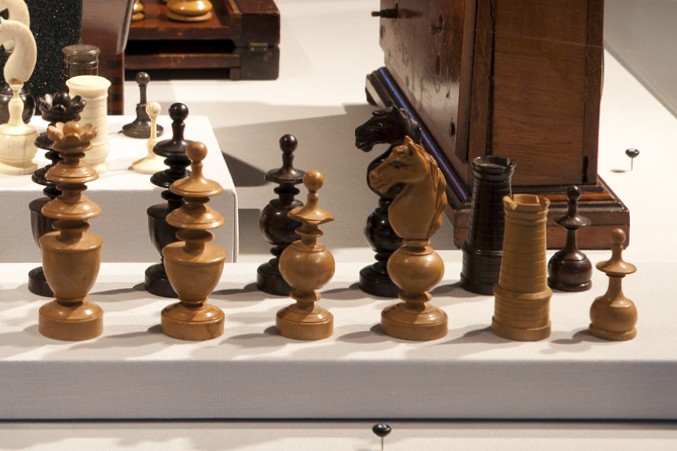
French Regence Set, Late 19th or early 20th Century
France
Wood with glass eyes
King: 3 3/4 in.
Photo © Michael DeFilippo
Chess surged in popularity in the nineteenth century, leading to a wider variety of chess set designs. The Régence style, seen here, was named after the Café de la Régence in Paris, where many skilled players and intellectuals congregated. Benjamin Franklin, who lived extensively in Paris, owned a Régence set. The knight is fitted with glass eyes, giving the piece an additional touch of realism.
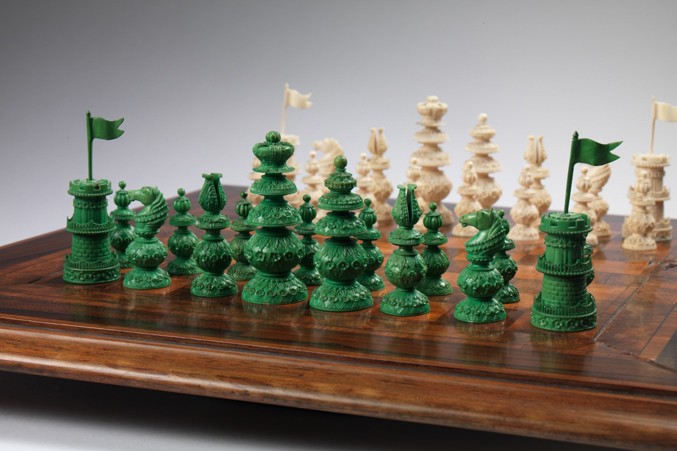
Berhampore Ivory Set, c. 1800-1850
India
Ivory
King: 3 1/2 in.
Photo © Bruce M. White, 2013
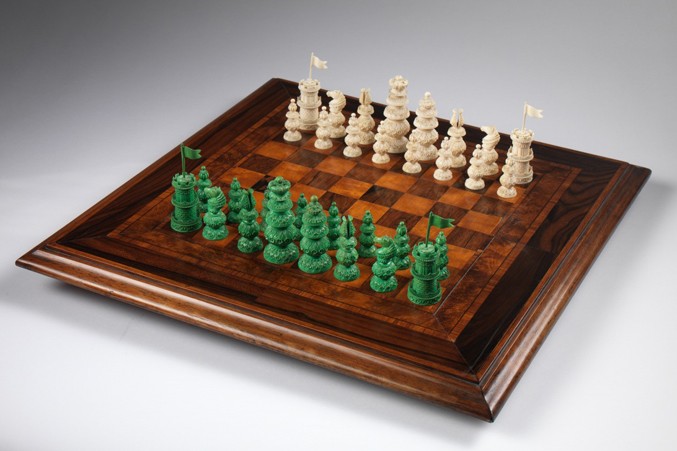
Victorian Wooden Chess Table, Late 19th Century
Britain
Wood
19 3/4 in. x 19 3/4 in.
Photo © Bruce M. White, 2013
Manufactured in Brahmapur, or Berhampur, a city located on India’s east coast, these chessmen boast finely detailed carvings featuring multiple tiers of leaves and flowers. Accompanying the pieces is a Victorian-era chess tabletop crafted in England. This juxtaposition of Asian and European craftsmanship would have been common in the mid-nineteenth century, when the British colonization of India reached its peak.
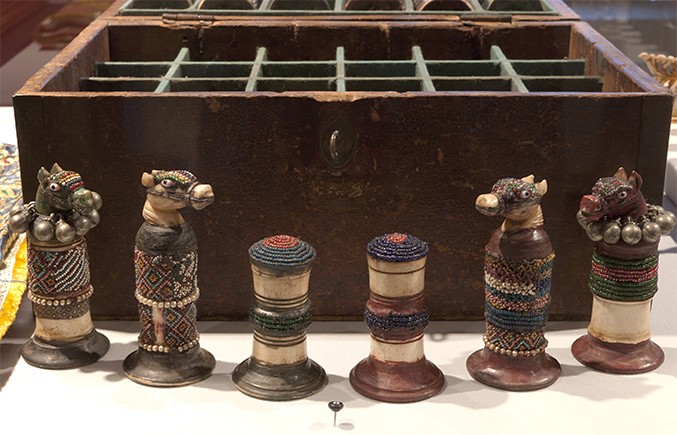
Lt. Col. James Tod Chess Set, c. 1818-1822
Pieces: Bone, glass beads, silver, laquer, pearls; King: 5 1/2 in.
Board: cloth; Board Size: 33 x 33 in.; Box: 13 1/2 x 9 3/4 x 15 3/4 in.
Photo © Michael DeFilippo
Lieutenant-Colonel James Tod, an officer of the British East India Company, arrived in India in 1799. In addition to his military service, he became a scholar of the region, traveling extensively and authoring several books, including the two-volume Annals and Antiquities of Rajasthan and the posthumously-published Travels in Western India. While undertaking his studies, Tod met and formed relationships with several local leaders, including the Thakur (Lord) of Amet, who gifted him with this bone chess set. Figurative representations of the back row pieces–king, queen, elephant, horse, and camel –sit atop pedestals adorned with beads. Each king is inscribed in Devanagari script with a title: the green king, representing the Thakur, as “the Governor of Amet,” and the red king, representing Tod, as “District Amet of the State of Mewar.” The set is further personalized with a miniature of the two men playing chess together, which was incorporated into the box, an indication of the high esteem in which Indian leaders held Tod.
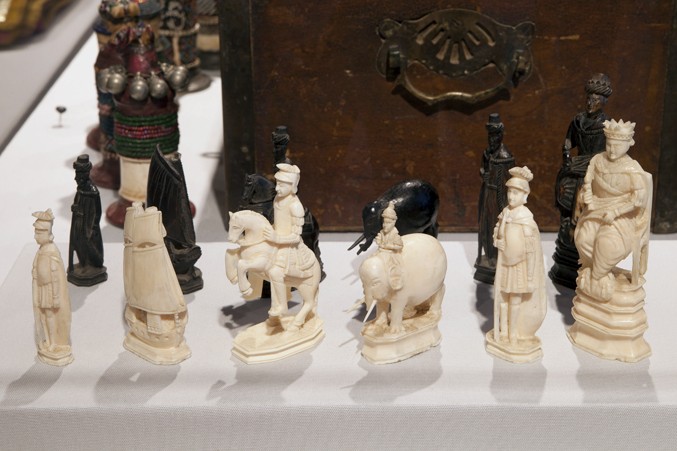
Russian Kholmogory Set, Late 18th Century
Russia
Walrus Ivory
King: 3 3/4 in.
Photo © Michael DeFilippo
The rooks represented by ships with unfurled sails are characteristic of sets created in the Russian city of Kholmogory. Like Dieppe, France, the city was known for its skilled ivory workers. Russian carvers used mammoth or walrus ivory to create chess pieces, rather than elephant ivory like carvers in countries with African or Asian colonies. The craftsmen of Kholmogory created sets with the theme of a Russian army warring against an eastern, Muslim enemy. Here, the Russians are in white and their foes are represented in black. Like Indian sets, this one features a military advisor in the place of a queen. The bishops are elephants, the rooks are ships, and the knights are military figures on rearing horses. Several of the figures on the Russian side wear Roman-style costumes, which may allude to the dress of Empress Catherine the Great’s personal guard.
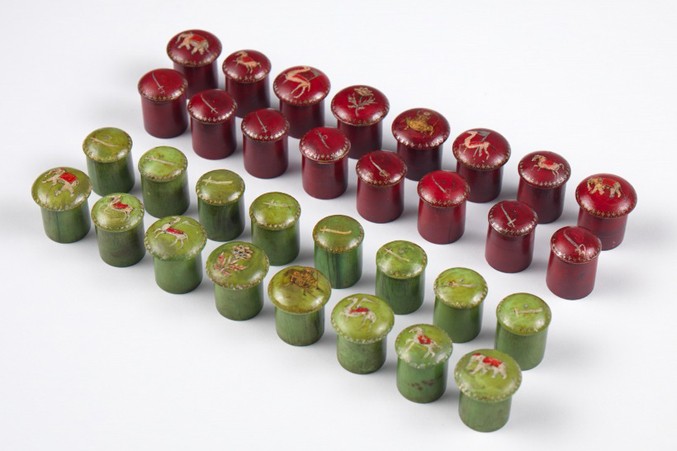
Mughal Decorated Ivory Set, Early 18th Century
India
Ivory
King: 1 1/4 in.
Photo © Bruce M. White, 2013
This rare and unusual design dates from the time of the late Mughal Empire, which was a power in the Indian subcontinent from 1526 to 1757. The pieces are ivory cylinders on which are painted finely rendered motifs representing the various chessmen: kings as gilt and throned rulers, queens as beautiful flowers, bishops as flagged camels, knights as prancing horses, rooks as elephants, and pawns as swords.
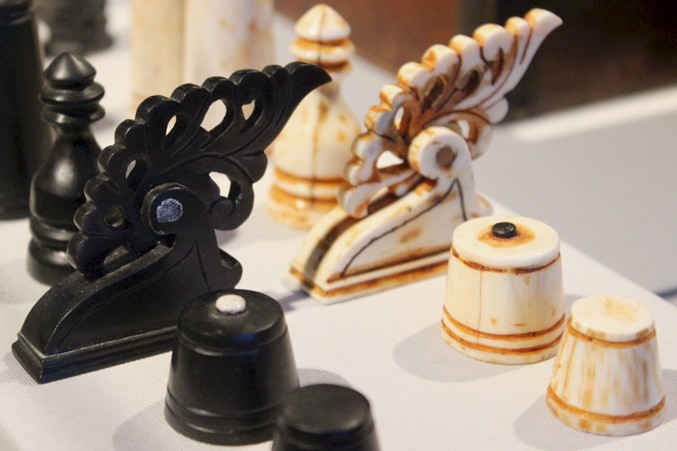
Moro Bone and Horn Chess Set, Mid-20th Century
Philippines
Bone and horn
King: 2 1/2 in.
Photo © Bailey Dolenc
The forms of the pieces in this set from the island of Mindanao in the Philippines are very simple, save for the knights carved in an okir shape, made of twisting, botanical elements. This shape is often carved on the corners of homes in the Philippines, and is said to be a symbol of good fortune capable of warding off natural disasters or fire.
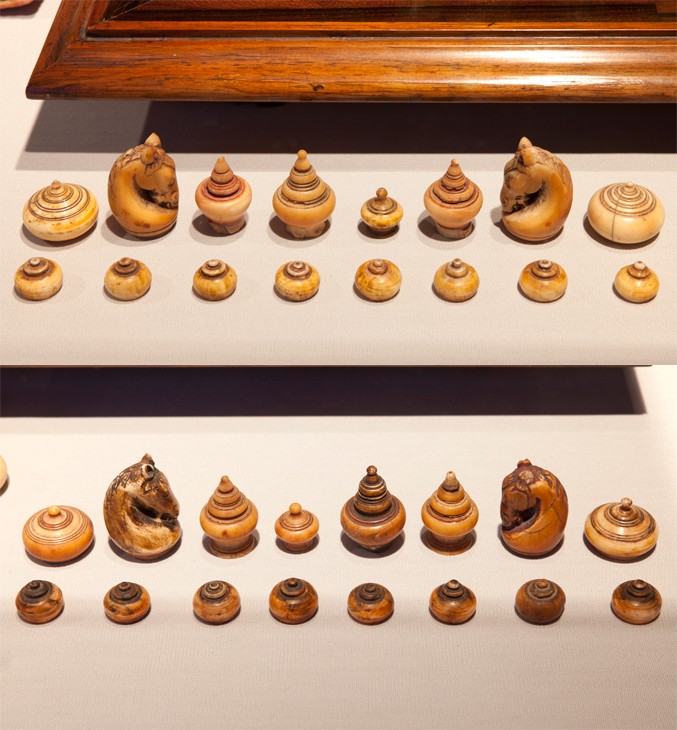
Cambodian Ivory Makrook Set, 18th Century
Cambodia
Ivory
King: 1 1/2 in.
Photos © Michael DeFilippo
Probably also developed from the Indian game chaturanga, Makrook (or Makruk) is considered the closest living game to chess. Played in Thailand and Cambodia, the identities and movements of certain pieces are modified and the game must be completed within a certain number of moves or it is declared a draw, but the main format and object of the game is the same.
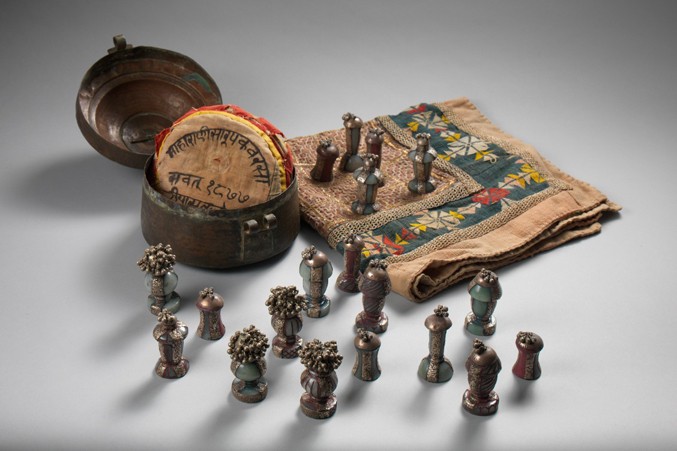
Dholpur Jade and Silver Chess Set, 1821
India
Jade and silver with cloth board
King: 3 1/2 in. Board: 28 3/4 x 28 3/4 in.
Photo © Bruce M. White, 2013
This set originated in the former kingdom of Dholpur, now a city in north central India. On the bases of the kings is the inscription “Maharaja Bhagvat Singh SV 1877.” The latter portion refers to the year 1877 in the Hindu Samvat calendar, which corresponds to the year 1821 CE. Maharaja, or “Great King,” Bhagvat Singh was a member of the Jat clan, which ruled Dholpur from 1806 until 1947, when the kingdom was absorbed into modern-day India. The textile board, which is original, is commonly found in Indian sets, and made them easily transportable. The original copper case and textile couchon, which were used to carry the set, are also on display.
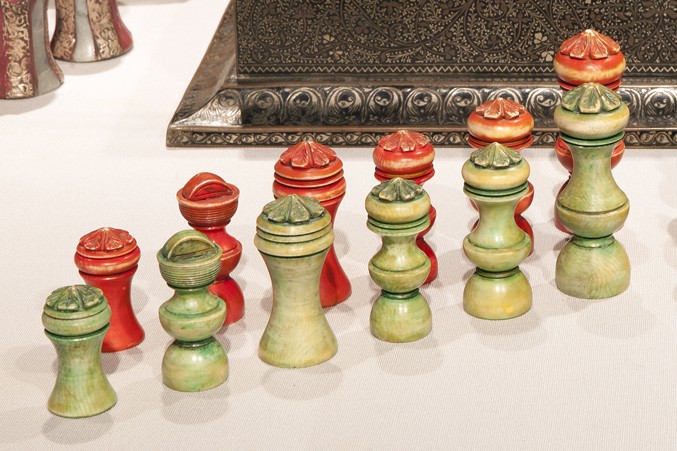
Islamic Ivory Set, 18th Century
India or Persia
Ivory
King: 2 1/4 in.
Photo © Michael DeFilippo
The worn stain around the tops of the pieces is evidence of the heavy use this playing set has experienced. The two sides are stained red and green, common colors in Indian chess sets. The pieces are very simple shapes, differentiated mainly by their height, and topped by flowers.
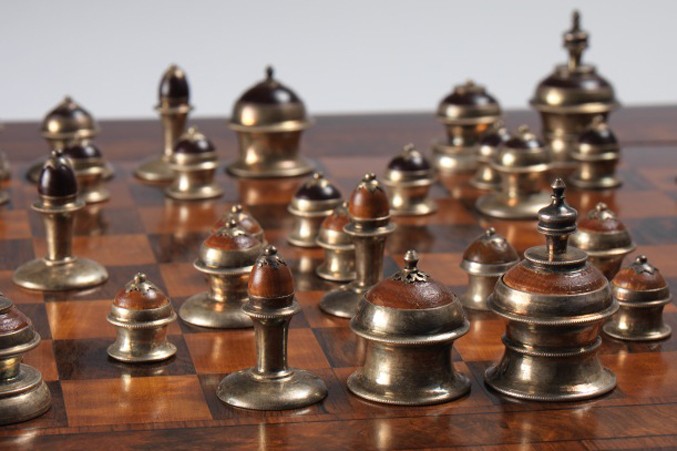
Silver and Wood Islamic Set, Late 19th or early 20th Century
Probably India
Wood and silver
King: 2 1/2 in.
Photo © Bruce M. White, 2013
The materials that comprise this set, silver and wood, enhance its simple beauty. The king is topped by a mount shaped like a tower, while the other pieces have mounts shaped like stars or flowers. The pieces derive their forms from architecture, perhaps in accordance with beliefs held by some Muslims that figural decoration should be avoided.
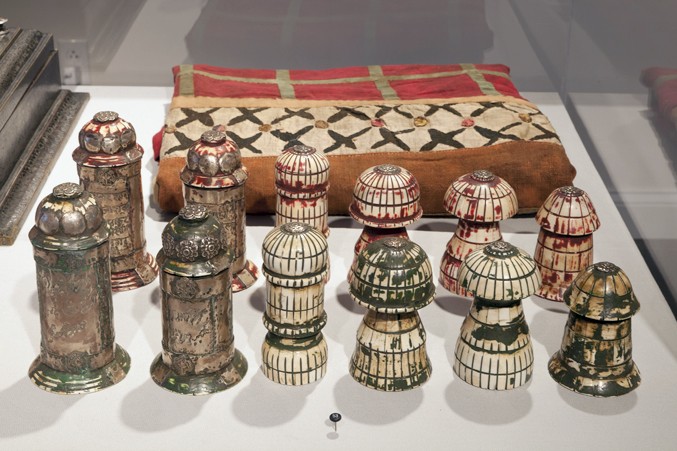
Indian Bone and Silver Inscribed Set, 1784
India
Bone, silver, and wood with cloth board
King: 5 1/2 in.; Board: 55 x 55 in.
Photo © Michael DeFilippo
This stunning Indian set features several details that pay homage to chess’ earliest forms. The size of the board and pieces indicates that it was probably designed for use in a large hall, and the two sides represent the Hindu and Muslim cultures that initially developed and shaped the game. The playing surface also is a nod to early Indian forms of the game, which was played on an uncheckered board called Ashtāpada. The kings and generals (queens) are inscribed with the names of the historical figures they represent. The red Hindu pieces, according to the Devanagari script, represent the late eighteenth-century general Ranjit Singh as the king and Thakur Sahib Jarowar Singh, a regional governor in Udaipur, in western India. The green Muslim pieces, likely in Urdu, have not yet been translated.
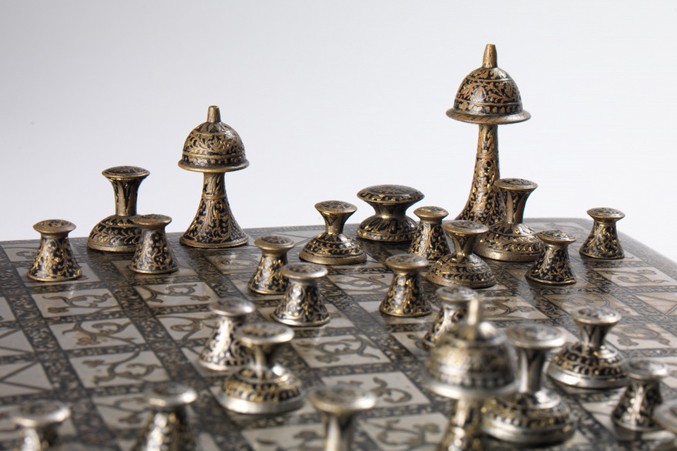
Islamic Brass Set and Board-Box, 19th Century
India
Silvered and black lacquered box and chess set
King: 2 1/2 in. Board: 14 x 10 x 4 1/4 in.
Photo © Bruce M. White, 2013
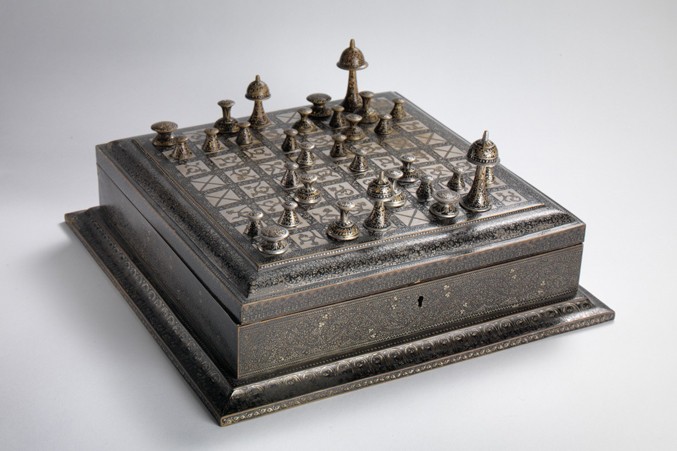
Islamic Brass Set and Board-Box, 19th Century
India
Silvered and black lacquered box and chess set
King: 2 1/2 in. Board: 14 x 10 x 4 1/4 in.
Photo © Bruce M. White, 2013
Elegant scrolling floral decorations animate the surfaces of the pieces in this rich chess set. The abstract forms of the pieces evoke the soaring spires, minarets, and massive domes sometimes found in Islamic architecture. The avoidance of figural representation conforms to the belief held by some Muslims that artists should avoid making figurative artwork, as creating forms was the work of Allah. The pieces are differentiated by size and mass rather than through figurative carving.
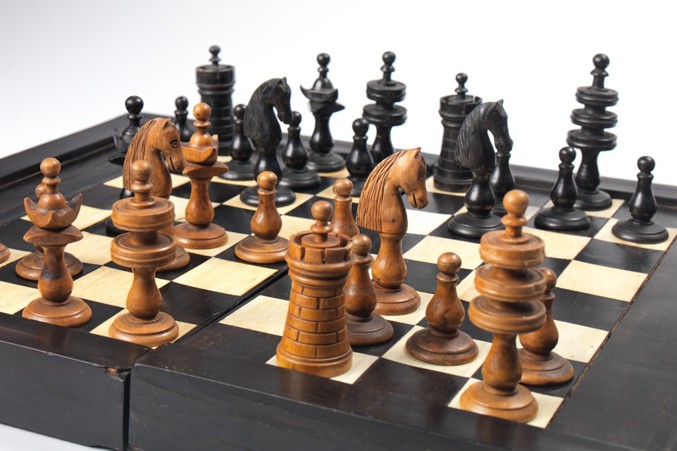
Italian or Spanish set, Late 17th-early-18th Century
Wood
Italy
King: 3 1/4 in.
Photo © Bruce M. White, 2013
Several Italian books of the late seventeenth and early eighteenth centuries featured chessmen similar to these in style, though they may have also originated in Spain. The pieces are paired with a folding chess board-box from the same era. An almost-identical device is depicted in Still Life with Chessboard, a 1630 painting by French artist Lubin Baugin.
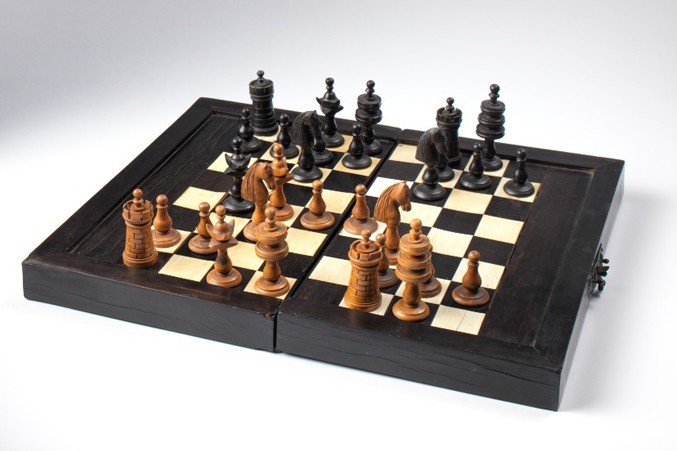
Very Early Chess Board-Box, c. 1625-1650
France
Ivory and wood
19 x 14 in.
Photo © Bruce M. White, 2013
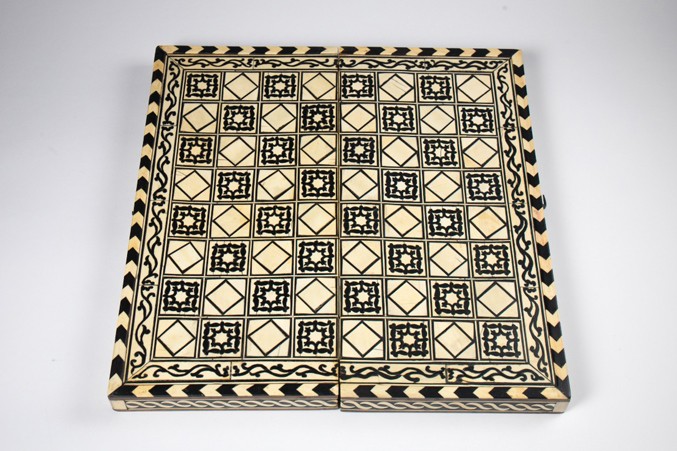
Spanish 17th Century Chessboard, c. 1625-1650
Spain
Ivory and wood
20 1/2 x 20 1/2 in.
Photo © Bruce M. White, 2013
This board, from the early seventeenth century, reflects the influence of Muslim Moorish culture on that of Spain, particularly in the art and architecture of the region. Featuring designs of wood inlay, the geometric patterns on this board are common in Islamic art.
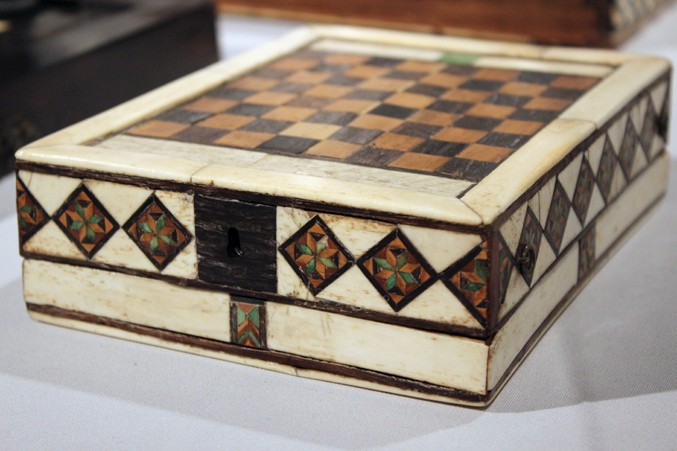
Embriachi Chess Board-Box, 15th Century
Italy
Certosina wood, bone, and horn
7 1/4 x 6 in.
Photo © Bailey Dolenc
Beginning in the late fourteenth century, the Embriachi workshops in Venice and Florence met the growing European demand for ivory or imitation ivory products. Baldassare Degli Embriachi started the firm around 1390, and later his two sons, Antonio and Giovanni, carried on his work. Bone, as in the case of this combination chess/backgammon board-box, often served as an acceptable substitute for the precious and expensive ivory. Also characteristic of Embriachi craftsmanship is the certosina technique, in which wood, bone, ivory, or mother-of-pearl are inlaid in a piece to create geometric patterns.
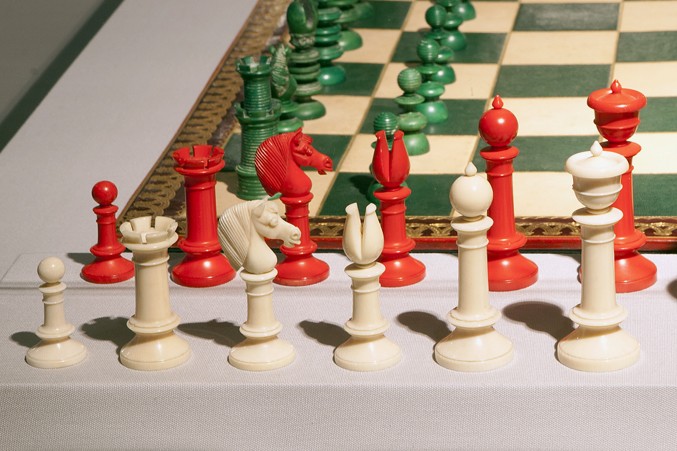
Northern Upright Ivory Set, c. 1825-1875
England
Ivory
King: 4 1/4 in.
Photo © Michael DeFilippo
By the mid-1800s, as chess was becoming more organized and competitive, there was a call for pieces to become distinct and uniform. The Upright style is considered a predecessor to the Staunton set, which eventually became the standard for all official chess competitions worldwide. The forms of the pieces sit atop slender columns, but the set’s clean lines and simple style bear a strong resemblance to the now-famous Staunton design. This set almost certainly was made by Jaques of London, as the company’s pattern book includes an identical design.
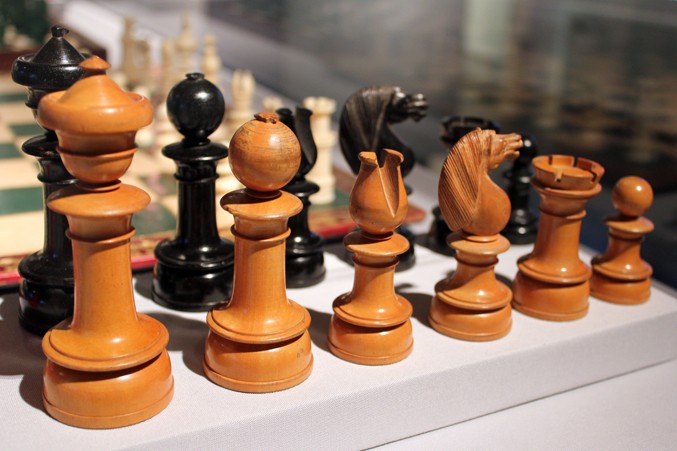
Northern Upright Set, c. 1850-1875
Scotland
Wood
King: 4 1/2 in.
Photo © Bailey Dolenc
Another name for Northern Upright style sets is Edinburgh sets. This Northern Uprights set is larger than the ivory one also included in this exhibition.
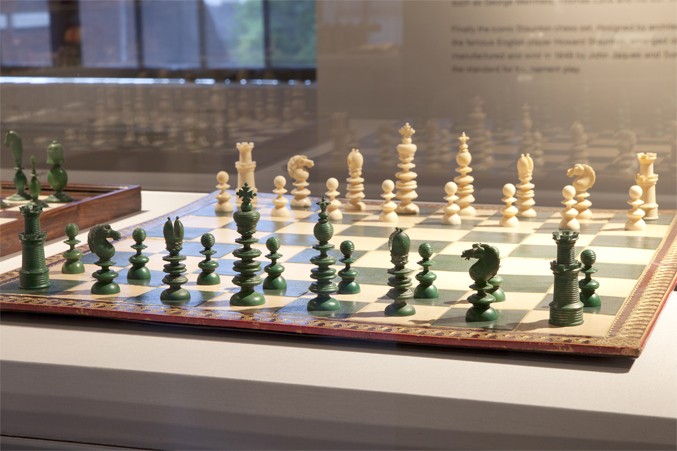
English Ivory Chess Set by Merrifield, c. 1825-1850
Leuchars green and white chessboard, c. 1850-1875
Pieces: England; Ivory; King Size: 3 1/2 in.
Board: England; Cloth, cardboard, cartonpierre; 21 x 21 in.
Photo © Michael DeFilippo
George Merrifield, a notable London craftsman, created this ivory set. His knights in particular are distinctive in style and shape, and can usually be used to distinguish a Merrifield set from other design firms of the period. A later Merrifield design, the ill-fated Philidor set, can also be found in this exhibition. The board is made of a material similar to plaster of Paris called carton-pierre, composed of paper pulp, whiting, and glue.
The striking green and white board was made by Leuchars. The firm was the first retailer of Staunton pattern sets, selling them in December 1849. This board is stamped with Leuchars and Piccadilly on its sides.
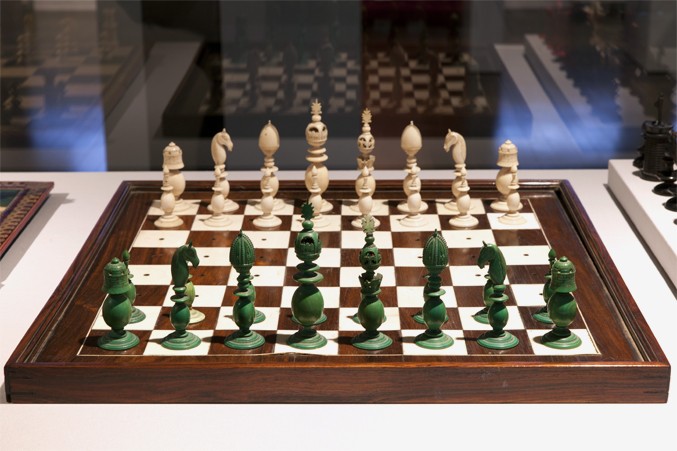
The William Daniell Chess Set, c .1790
India
Ivory with rosewood and ivory board
King: 4 in. Board: 17 1/4 x 17 1/4 in.
Photo © Michael DeFilippo
William Daniell was an English painter and engraver in the late eighteenth and early nineteenth centuries. He lived and worked in India with his uncle, Thomas Daniell, from age fourteen to his mid-twenties, during which time they traveled around the country extensively to create engravings of the natural landscapes. It was during one of these travels, aboard the East India Company ship the Exeter, that William received this chess set from a Mr. Dickinson, as noted in an inscription on the board. With pegged pieces and accompanying holes in each of the squares to prevent the pieces from shifting, this set is ideal for travel.
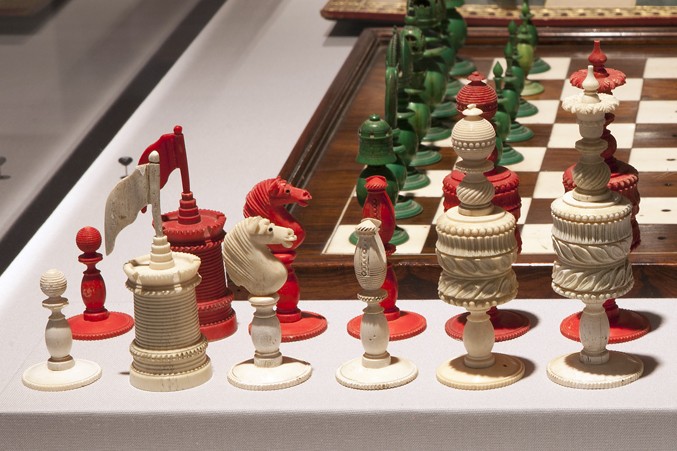
Large Barleycorn Set, c. 1825-1850
England
Bone
King: 5 in.
Photo © Michael DeFilippo
Barleycorn styles sets abounded in England in the early to mid-nineteenth century. The style also gained favor in the United States–Benjamin Franklin owned a set of this type. Their popularity declined after the creation of the Staunton set. Usually made of bone, barleycorn sets were turned in sections that were then screwed together. The queen on this set has a ball finial, while the king has petal-like decorations.
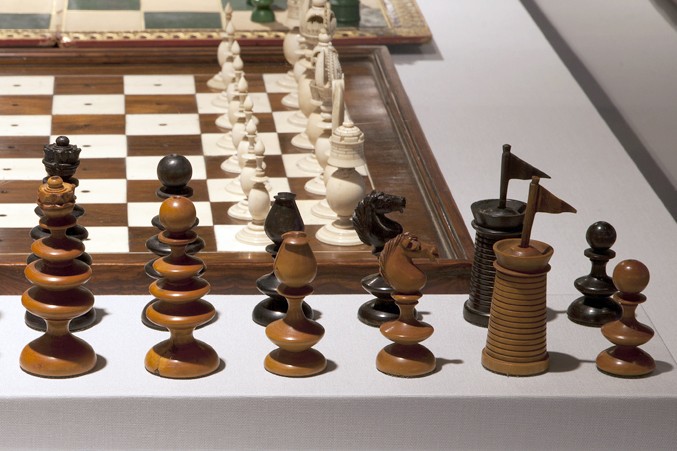
Early English Wooden Set, late 18th or early 19th Century
England
Wood
King: 3 1/2 in.
Photo © Michael DeFilippo
Though a seemingly minor feature, the flags flying from atop the rooks distinguish this set. Flags are relatively common features on ivory and bone sets, but are almost unseen on wooden pieces. These flags are modern replacements.
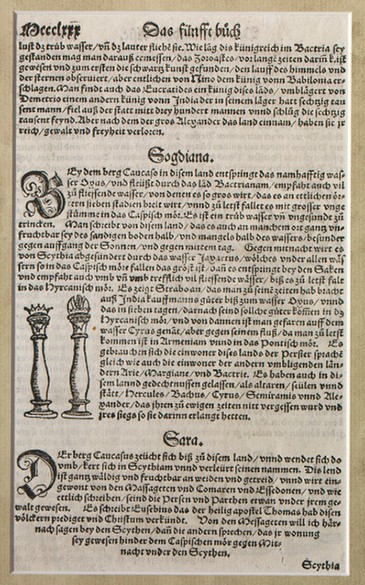
Cosmographia Leaf, 1561
Germany
18 x 13 3/4 in.
Photo © Bruce M. White, 2013
The Cosmographia, written by cartographer and cosmographer Sebastian Münster in 1544, is the earliest German description of the world. This leaf includes illustrations and descriptions of two chess pieces, which appear in a section on Sogdiana, an ancient Iranian civilization, which reached its height around the 6th century. It enjoyed close cultural and trade ties to India, the birthplace of chess. Established as the region’s traders and merchants, Sogdians were likely instrumental in bringing the game from India to other cultures via the Silk Road.
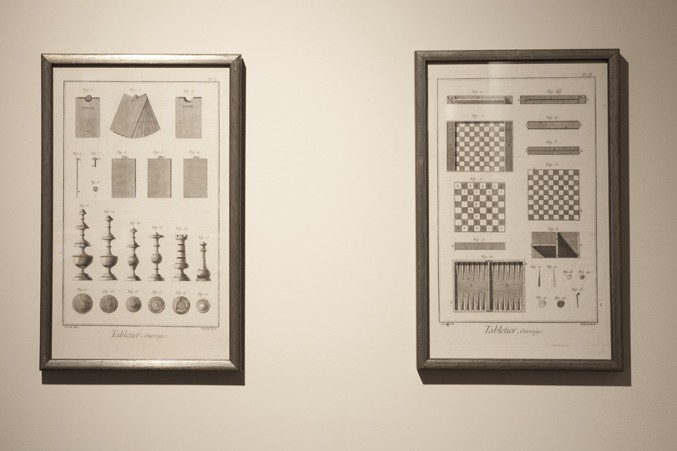
Diderot Engraving Plates, 1776
France
16 x 10 1/4 in.
Photo © Michael DeFilippo
A successful philosopher, art critic, and writer, Denis Diderot compiled and published an encyclopedia of crafts between 1751 and 1772. The finished product included seventeen volumes of text and eleven volumes of illustrations. It had an enormous impact on both eighteenth-century audiences and modern-day scholars interested in learning about the techniques of artists and craftsmen of the period. These two pages of engravings depict chess pieces and game boards.
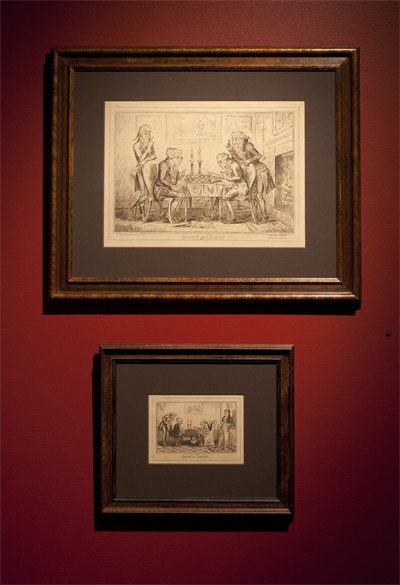
Game of Chess (1 and 2), Cruikshank, 1835
England
22 1/2 x 19 in.
Photo © Michael DeFilippo
George Cruikshank was a nineteenth-century cartoonist and illustrator. He is most famous for his book artwork, including editions of Grimm’s Fairy Tales, Pilgrim’s Progress, Paradise Lost, and several Charles Dickens novels, but he also dabbled in caricatures and satire of the British monarchy and topics of social and moral concern. These engravings, both entitled Game of Chess, depict a games taking place between two aristocratic gentlemen. Initially appearing two decades earlier, they were republished in an 1835 compendium of the work of George and his brother Robert entitled Cruikshankiana.
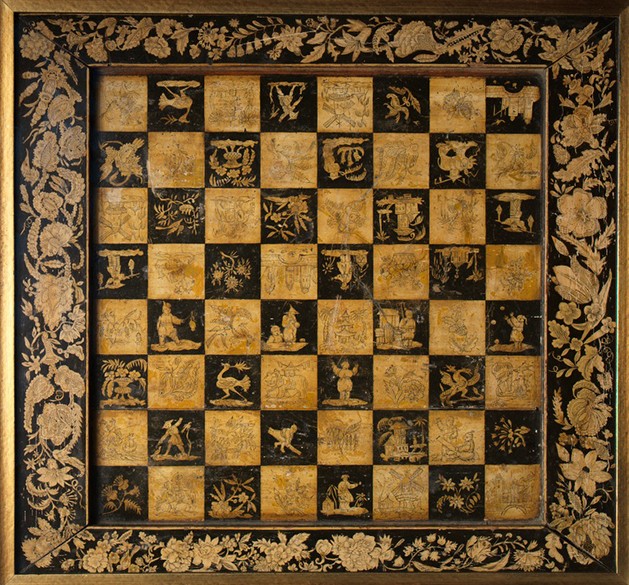
Thomas Tallock
Pen and ink board, 1831
England
26 3/4 x 26 3/4 in.
Photo © Bruce M. White, 2013
The incredible detail on this board is achieved through pen and ink drawings, setting it apart from other chessboards that more commonly feature designs of inlaid stone or wood. The artist, Thomas Tallock, surreptitiously hid his name and the set’s date of completion in a bird and a leaf that adorn the perimeter of the board. His choice of a blue and white theme, as well as the drawings themselves, call to mind Chinese export porcelain, which was popular in Europe and later North America from the sixteenth through the twentieth centuries.
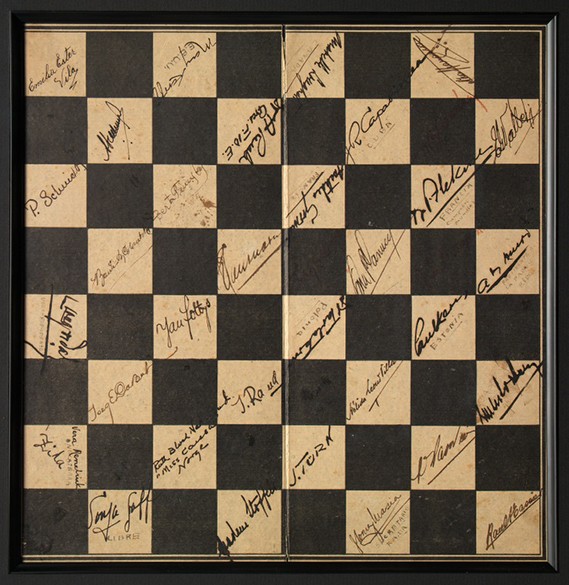
Chess board with autographs—1939 Chess Olympiad, 1939
Europe
19 3/4 x 19 3/4 in.
Photo © Bruce M. White, 2013
The Chess Olympiad, established in 1927, is a biennial chess competition featuring teams of players from various countries. This autographed board is from the 1939 competition. Included are signatures from world champions Alexander Alekhine and José Raúl Capablanca, women’s world champion Vera Menchik, as well as Paul Keres and Sonja Graf, among those of other notable chess players.
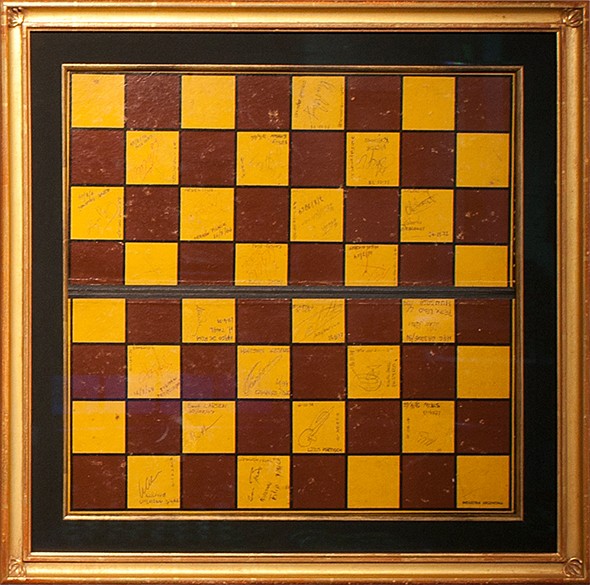
Autographed Chess Board—20th century signatures, 1970-2000
Buenos Aires, Argentina
23 1/4 x 23 1/4 in.
Photo © Michael DeFilippo
The signatures on this chessboard were collected over the course of the late twentieth century.They include some of the twentieth century’s best chess players, including world champions Tigran Petrosian, Mikhail Tal, and Vasily Smyslov, and other players of international renown including Bent Larsen, Peter Leko, Leonid Stein, Lajos Portisch, Wolfgang Uhlmann, Miguel Najdorf, Erich Eliskases, Oscar Panno, Miguel Quinteros, and Herman Pilnik.
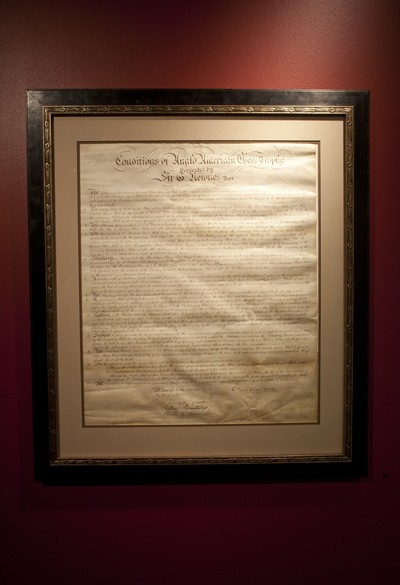
Newnes—Conditions of the Anglo American Chess Trophy—1896, 1896
England
33 1/2 x 28 1/4 in.
Photo © Michael DeFilippo
In March of 1896, an Anglo-American cable chess match was played between the British Chess Club and the Brooklyn Chess Club. The American team won by a single game, 4½-3½, and the competition became almost an annual event until 1911. This parchment document lays out the terms and conditions of the first match, and is signed by the relevant parties on both sides of the Atlantic. The match trophy was named for Sir George Newnes, an English publisher and editor who provided and presented it to the winning team. During the thirteen years the match was played, each team won six times, and the 1901 match was drawn.
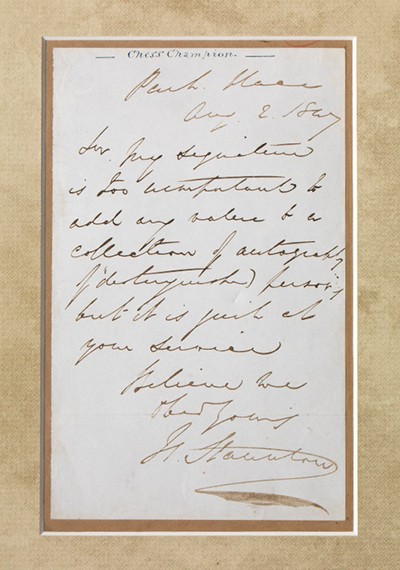
Staunton Handwritten Letter, 1847
England
15 x 11 3/4 in. Photo © Bruce M. White, 2013
Howard Staunton, who lent his name to the style of chess set that would become the international standard, was one of the world’s strongest chess players in the mid-19th century. With characteristic false modesty, belied by the “Chess Champion” stationery on which the note is written, he composed this letter, dated August 2, 1847. The body of the text reads, “Sir, my signature is too unimportant to add any value to a collection of autography of distinguished persons, but it is quite at your service. Believe me.”
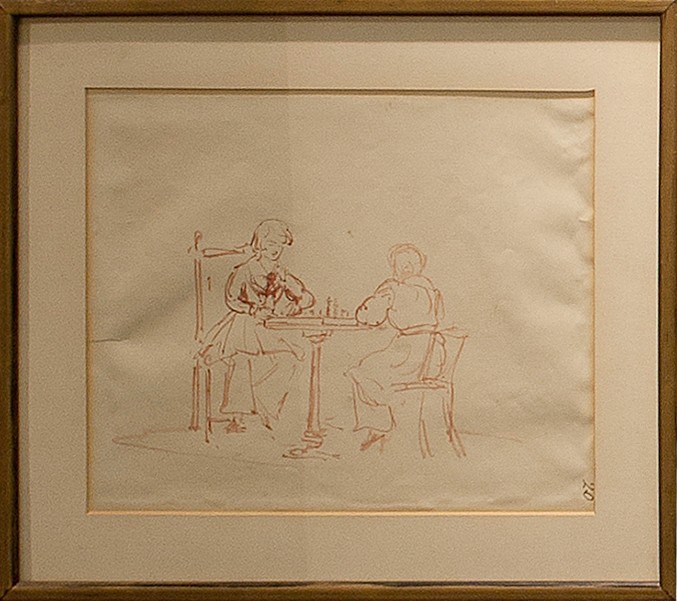
John Everett Millais
Chess sketch, 1850
England
11 3/4 x 9 3/4 in.
Photo © Michael DeFilippo
John Everett Millais was a painter, illustrator, and co-founder of the Pre-Raphaelite art movement. The Pre-Raphaelites looked to medieval and Renaissance painting for inspiration, emphasizing storytelling, morality, and attention to nature. This ink sketch was composed early in Millais’ career, and is one of only two chess-related artworks he produced.
Carl Alexander Heideloff—Chess Print, 1851
Germany
12 x 9 1/2 in.
Carl Alexander Heideloff was a German architect and master builder of the city of Nuremburg. He was principally inspired by the Gothic style, and between 1838 and 1842, he published the massive 24-volume Ornamentik des Mittelalters, or Ornamental Art of the Middle Ages, which highlighted Gothic- and medieval-influenced designs for nineteenth-century craftsmen, including goldsmiths, turners, potters, and carpenters. Theis print highlights a design for a chess set that could be made by a turner, a woodworker who “turns” wood on a lathe.
Testimonial to Paul Morphy, 1859
United States
9 x 6 in.
Paul Morphy was the first American prodigy and perhaps the greatest player of his era. After winning the First American Chess Congress in 1857, becoming the unofficial champion of the United States at the age of 20, Morphy travelled to Europe, where the level of competition was considerably higher. There, he dominated the competition to such a degree that, by early 1859, his peers generally hailed him as world champion. Upon returning to the United States in May of that year, a ceremony was held in his honor at the University of the City of New York. John van Buren, son of President Martin van Buren, presented this testimonial declaring Morphy “Chess Champion of the World.”
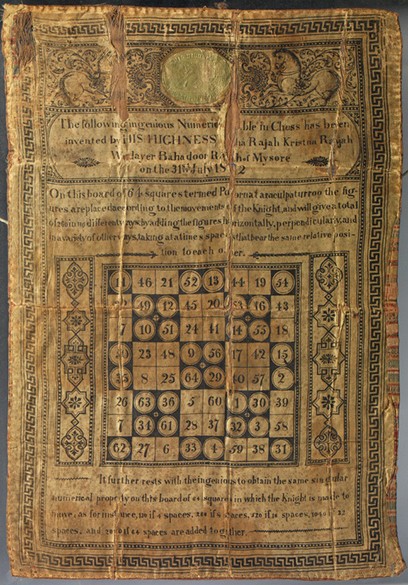
Indian Silk Magic Knight’s Tour, 1852
India
Silk
21 1/4 x 16 in.
Photo © Bruce M. White, 2013
The knight’s tour is a complicated sequence of moves in which the knight lands on every square of the chessboard once and only once. Despite its complexity, there are trillions of ways to complete a knight’s tour; modern calculations put the number of potential successful tours at 26,534,728,821,064. This silk document depicts one example, which is ascribed to the Rajah of Mysore, the ruler of a kingdom in southern India. The numbered squares indicate the order in which the knight should move.
Press
Prized and Played Exhibition Press Release
6/4/14: St. Louis Public Radio — On Chess: Circus Flora Plays Both Sides Of The Board
5/29/13: ArtDaily.org — Prized and Played: Highlights from the Jon Crumiller Collection opens at the World Chess Hall of Fame
